


REPORT FROM THE FLORIDA HOUSING COALITION 2023 Take a picture of this QR code to visit the Home Matters Webpage to use all of our interactive dashboards.
THE FLORIDA HOUSING COALITION | FLHOUSING.ORG HOME MATTERS 2023 TABLE
CONTENTS Quick Facts � � � � � � � � � � � � � � � � � � � � � � � � � � � � � � � � � � � � � � � � � � � � � � � � � � � � � � � � � � � � � � � � � � � � � � � � � 2 Florida still has a housing affordability crisis � � � � � � � � � � � � � � � � � � � � � � � � � � � � � � � � � � � � � � � � � � � � � � � � � � � � � � � � � 2 Why Does Home Matter? � � � � � � � � � � � � � � � � � � � � � � � � � � � � � � � � � � � � � � � � � � � � � � � � � � � � � � � � � � � � � 3 Housing that is affordable reduces taxpayer expenses �������������������������������������������������� 3 Housing affordordability boosts the economy 3 SECTION ONE Introduction: Why Does Home Matter? 4 The Benefits of Housing Affordability � � � � � � � � � � � � � � � � � � � � � � � � � � � � � � � � � � � � � � � � � � � � � � � � � � � � � � � � � � � � � � 5 Economic Benefits 5 Health and Education Benefits 6 SECTION TWO By The Numbers: Housing Cost Burden in Florida �������������������������������������������� 8 Housing Costs for Low-Income families 8 Housing Cost Burden and Tenure 8 L Low-Wage Jobs 9 Can the Workforce Afford to Live in Florida 9 Homelessness 11 SECTION THREE Challenges for Renters ����������������������������������������������������������������������� 11 Shortage of Affordable and Available Rental Units 11 L Loss of Affordable Rental Housing�������������������������������������������������������������������� 11 Rising Rents 11 SECTION FOUR Challenges for Homebuyers 13 Rising Home Prices 13 Racial Disparities in Homeownership and Housing Instability���������������������������������������������� 15 New Single-Family Home Construction Levels Out While Supply of Inventory is Up 17 SECTION FIVE Resilience and Disaster Recovery � � � � � � � � � � � � � � � � � � � � � � � � � � � � � � � � � � � � � � � � � � � � � � � � � � � � � � 18 Hurricane Ian � � � � � � � � � � � � � � � � � � � � � � � � � � � � � � � � � � � � � � � � � � � � � � � � � � � � � � � � � � � � � � � � � � � � � � � � � � � � � � � � 18 Impacted Publicly Assisted Housing 20 Impacted Underserved Households 20 Resilience and Disaster Recovery Planning � � � � � � � � � � � � � � � � � � � � � � � � � � � � � � � � � � � � � � � � � � � � � � � � � � � � � � � � � 21 Analytical Inputs 21 Engagement & Coordination 22
OF
FLHOUSING.ORG | THE FLORIDA HOUSING COALITION A REPORT FROM THE FLORIDA HOUSING COALITION SECTION SIX Solutions 23 Permanent Affordability and Community Land Trusts � � � � � � � � � � � � � � � � � � � � � � � � � � � � � � � � � � � 23 Public Funding Programs 25 Federal 25 State � � � � � � � � � � � � � � � � � � � � � � � � � � � � � � � � � � � � � � � � � � � � � � � � � � � � � � � � � � � � � 26 Local 28 Land Use Policies & Developmental Regulations 28 Zoning Reform � � � � � � � � � � � � � � � � � � � � � � � � � � � � � � � � � � � � � � � � � � � � � � � � � � � � � � � 28 Inclusionary Housing 29 Impacts of the Live Local Act 30 Community-Based, Nonprofit & BIPOC Developer Capacity � � � � � � � � � � � � � � � � � � � � � � � � � � � � � � 31 Conclusion ���������������������������������������������������������������������������������� 32 Affordable Housing is Essential for Floridians � � � � � � � � � � � � � � � � � � � � � � � � � � � � � � � � � � � � � � � � � � � � � � � � � � � � � � � 32 We Don’t Have Enough Affordable Housing in Florida 33 There is a Large and Growing Gap Between Income and Housing Costs 33 The Good News ��������������������������������������������������������������������������������� 33 Endnotes������������������������������������������������������������������������������������ 36
Quick Facts
Florida still has a housing affordability crisis
• Over 2 4 million low-income Florida households pay more than 30% of their incomes towards housing, the maximum amount considered affordable by experts, with over half, 1 3 million low-income households, paying more than 50% This makes it nearly impossible to save for retirement or emergencies and difficult to afford other basic necessities like food and childcare�
• Though Florida has seen a significant decrease in homelessness over the past ten years, there are still over 25,000 individuals and families experiencing literal homelessness on any given night throughout the state and over 78,277 students without a permanent place to live

• Florida has only 23 affordable and available rental units for every 100 extremely low-income renters (those with incomes at or below 30% of the area median) No community in Florida provides enough housing to support this group which is primarily made up of low-income workers, retirees, and people with disabilities�
• Over 83,687 units are at risk of being permanently lost from the privately -owned affordable housing stock by 2043
THE FLORIDA HOUSING COALITION | FLHOUSING.ORG HOME MATTERS 2023
2
Why Does Home Matter?

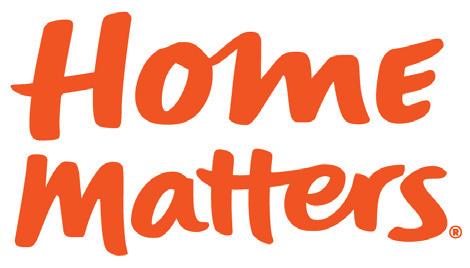
The health, safety, and welfare of Floridians and the strength of Florida’s economy depend on a sufficient supply of housing that is affordable for all of Florida’s households, including working families, older adults, and people with disabilities living on fixed incomes
Housing that is affordable reduces taxpayer expenses�
• For seniors, older adults and people with disabilities, the cost of affordable housing that is community-based is signifcantly less than the cost of institutional care�
• Chronically homeless persons often cycle through jails, hospitals, and other crisis services Permanent, supportive housing for this high-need population considerably reduces the cost to taxpayers
• Housing that is affordable can improve low-income families’ and children’s health and educational outcomes, reducing the public costs associated with illness and poor school performance
Housing affordability boosts the economy
• Money spent on housing construction and rehabilitation has a ripple effect on local economies Contractors and suppliers spend money on materials and labor, and workers spend their earnings locally
• The legislature’s allocation to the Sadowski Housing Trust Fund programs in FY 2023-2024 through the Live Local Act will create nearly 57,000 jobs and have $7 2 billion in positive economic impact in just one year while creating homes lasting far into the future 1
The Florida Housing Coalition has produced this report in support of Home Matters (www. HomeMattersAmerica.com), a national movement to make Home a reality for everyone by elevating the importance of Home’s impact on people’s health, education, personal success, public safety, and the economy. Participating in Home Matters is a coast-to-coast coalition composed of members of the general public, leaders of housing and community development organizations, as well as other organizations concerned about increasing the positive impact of home in their communities.
FLHOUSING.ORG | THE FLORIDA HOUSING COALITION A REPORT FROM THE FLORIDA HOUSING COALITION
3
SECTION ONE:
Introduction: Why Does Home Matter?
When it comes to housing, Florida has seen both triumphs and ongoing challenges in 2023 Florida enjoys access to an incredible source of funding for housing: the Sadowski State and Local Government Housing Trust Funds This year, we witnessed the passage of the most transformative housing legislation since the Sadowski Act Championed by Senate President Kathleen Passidomo, the 2023 Live Local Act marks a historic milestone in our continued efforts to address housing needs In addition to various land use, property tax, and other policies aimed at building more affordable housing, the Act also fully funded the State Housing Initiatives Partnership (SHIP) and State Apartment Incentive Loan (SAIL) programs with $511 million for the 2023-2024 fiscal year� After including the additional housing projects supported by General Revenue, the Legislature appropriated well over $1 billion in total for housing� This is largely due to the work of the Sadowski Coalition, Sadowski Affiliates, and all those who worked to include language in Senate Bill 2512 from the 2021 Legislative Session, which codified into law that all monies collected in the State and Local Government Housing Trust Funds be used for housing�
Even though the Live Local Act marked a historic moment in how the state Legislature approaches affordable housing policy, the work continues� This is an incredibly important time for the housing ecosystem to work together to implement the tools in the Live Local Act and build more affordable homes to continue to demonstrate that Florida’s housing programs are the best in the nation Also, moving into this next legislative session, advocates must continue to ensure that the core Sadowski Trust Fund programs of SHIP and SAIL are fully funded to address Florida’s increasing affordability challenges and continue to ensure that effective and well-reasoned funding, land use, property tax, and other state and local policies are designed to serve Floridians most in need
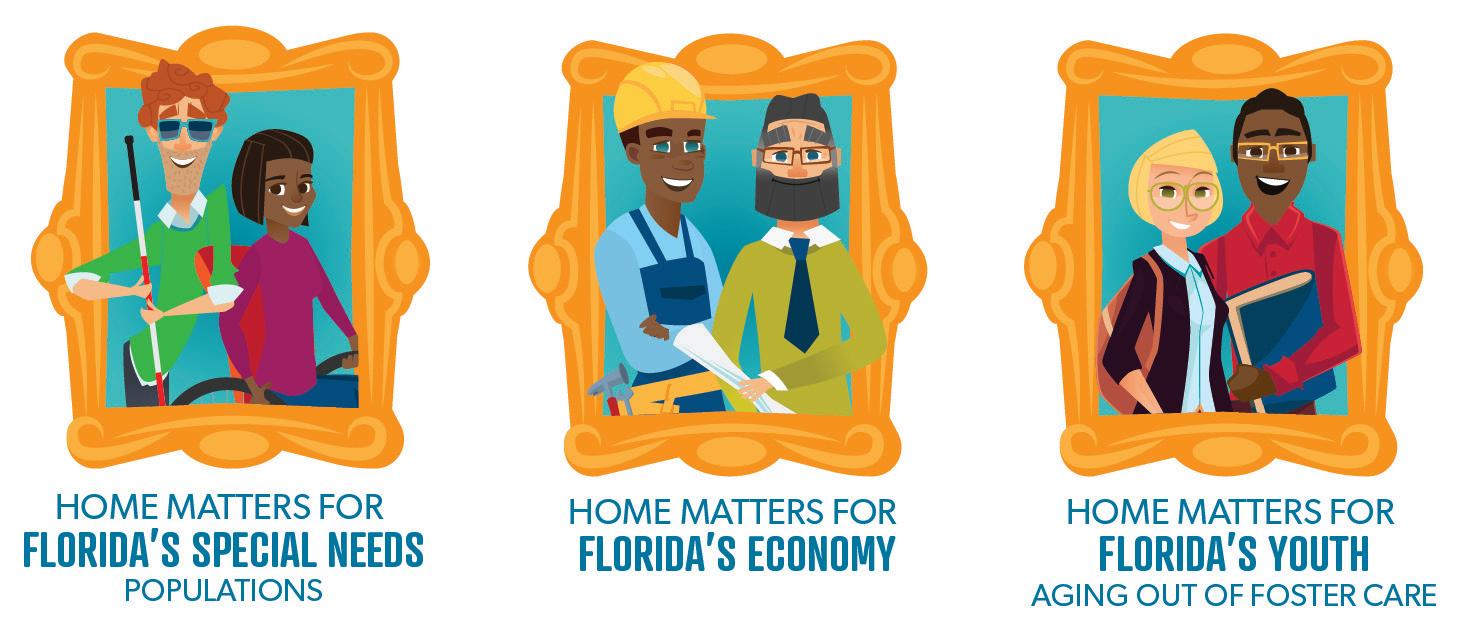

Everyone needs a safe, stable place to call home
However, because housing is a market commodity priced at whatever the market will bear, the private market by itself cannot provide homes and apartments for many workers, older adults, and people with disabilities The price of housing reflects what people are willing to pay to live in a community and the supply of homes, and many people are bidding high prices to live in Florida’s vibrant cities and towns while not enough new homes have been built since the 2008 Great Recession to keep up with demand In many communities, even modest homes and
apartments are priced out of reach for essential workers (including teachers and police officers) or are torn down and replaced with high-end houses, apartments, and condominiums� Even in communities with more moderate housing costs, many residents struggle to find good quality affordable housing, particularly those working in low-wage jobs or living on fixed incomes
The way to address housing affordability challenges is to provide financial and regulatory incentives that make it profitable for private developers to invest in affordable housing These incentives come from public-private partnerships among lenders; real estate professionals; community-based nonprofit organizations; and local, state, and federal agencies Housing funders typically require standards for building quality, amenities, and property management that equal or exceed market rate housing, ensuring that subsidized units look and feel like any other home Every partner and every funding source in this community effort – public, private, and nonprofit – is an essential piece of the puzzle This report outlines the greater need for rental and ownership housing affordability in Florida and highlights the importance of the Sadowski State and Local Trust Funds, as well as other key solutions that work in concert to address this need�
A REPORT FROM THE FLORIDA HOUSING COALITION FLHOUSING.ORG | THE FLORIDA HOUSING COALITION 1
4
HOME MATTERS 2023
THE FLORIDA HOUSING COALITION | FLHOUSING.ORG
What is Housing that is Affordable?
Misconceptions are widespread, with many people associating “affordable housing” with large, distressed public housing projects in central cities That perception simply does not fit reality
The majority of Public Housing Authorities nationwide, from large to small, are well-managed and have quality units� Furthermore, public housing is only one type of housing that is affordable In this report, “housing that is affordable” refers to housing that is safe and affordable in the private market, publicly owned housing, and privately owned housing that receives a subsidy to bring its rent or purchase price down to a level that is affordable to a low- or moderateincome family�
Substandard housing is, by definition, not considered affordable
The Benefits of Affordable Housing
Economic Benefits
Housing stimulates state and local economies� When a developer creates housing that is affordable through new construction or rehabilitation, the community gains jobs through direct, indirect, and induced economic impacts (see Sidebar on p 2 ) 2 For example, each dollar of Sadowski State and Local Housing Trust Funds leverages $4 to $6 in private investment, federal tax credits, and other funding sources With the 2023-2024 appropriation to the Sadowski State and Local Housing Trust Fund programs, the projected economic impact is:
• Over $7 2 billion in positive economic benefit
• More than 56,000 jobs
Once a housing development is built and occupied, the residents create demand for ongoing jobs to meet their needs Additionally, when housing is affordable, families have more discretionary income to spend on food, clothing, and other goods and services, thereby boosting the local economy 3
With the Sadowski State & Local Housing Trust Fund Monies fully appropriated for housing in FY 2023/24, THE
PROJECTED ECONOMIC IMPACT WILL BE:
Nearly
56,000 JOBS for Floridians
More than $7.2 Billion in Positive Economic Benefits
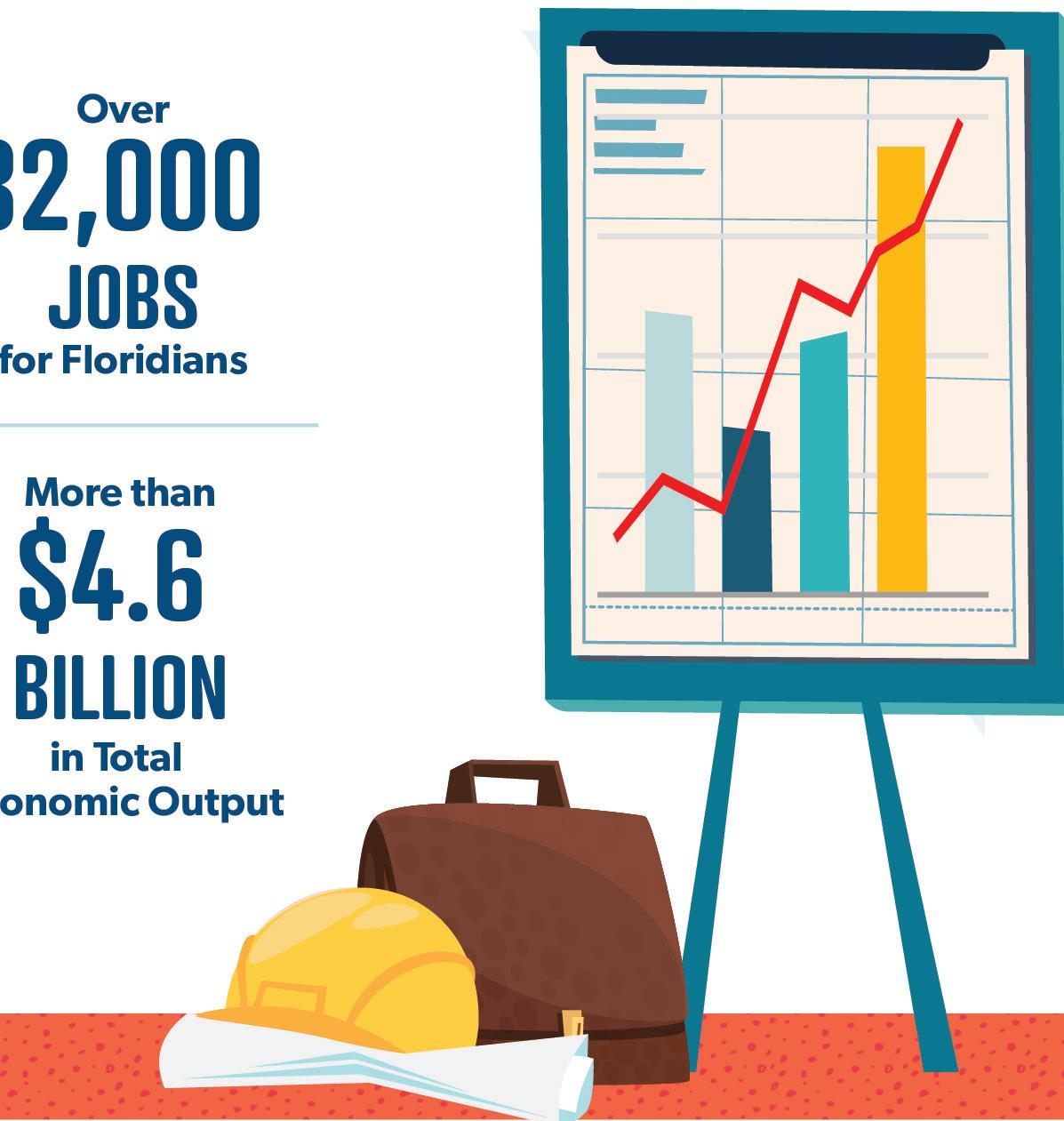
HOME MATTERS 2023 THE FLORIDA HOUSING COALITION | FLHOUSING.ORG 2
A REPORT FROM THE FLORIDA HOUSING COALITION THE FLORIDA HOUSING COALITION | FLHOUSING.ORG 5
Housing affordability is also important for employers trying to attract skilled workers to a region When local housing costs near employment sites are out of reach for entry-level and mid-level employees, employers may find it challenging to attract skilled workers and may face employee absenteeism and turnover 4,5
An additional economic benefit of affordable housing comes from the foregone costs of providing social services to older adults, those living with disabilities, or those experiencing homelessness Studies show that home- and communitybased services for older adults and permanent supportive housing for persons with disabilities are significantly more cost effective than institutionalized care or relying on jails and emergency rooms�6,7 An investment in housing that is affordable is fiscally responsible, with a significant return on investment�
Health and Education Benefits
Housing plays a significant role in our physical and mental health� For lowincome individuals and families, a lack of housing that is affordable can have a multitude of adverse effects, including:
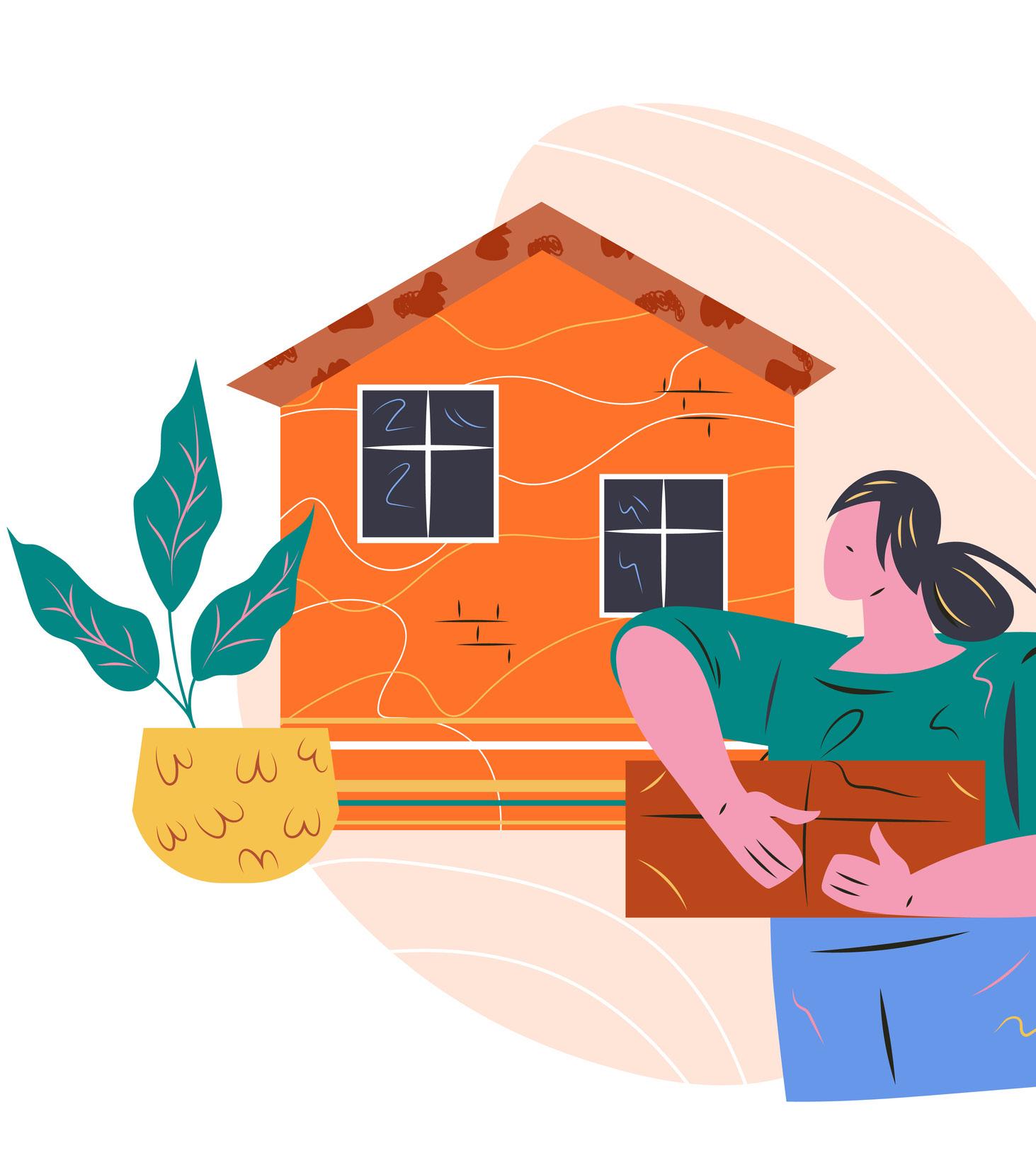
• Families in unaffordable housing will likely cut back on nutritious food and health care 8
• Access to safe, uncrowded housing is central to preventing the spread of infectious diseases Households and individuals that are doubling up, “couch surfing,” or experiencing other housing instability issues are more likely to get and spread COVID-19 and other infectious diseases 9
Housing Plays a Major Role
IN OUR PHYSICAL & MENTAL HEALTH
For low-income individuals and families, lack of housing that is affordable can have a multitude of negative effects�
FOOD & HEALTH CARE

Families in unaffordable housing are likely to cut back on nutritious food and health care
HEALTH HAZARDS
Economic Impacts: A Note On Terminology
Activities such as housing construction and rehabilitation stimulate local economies in several ways For housing development, “direct” impacts occur when developers hire workers and purchase materials from local suppliers In turn, the suppliers purchase additional materials and labor to fill the developer’s order, producing “indirect impacts ” The workers that are employed further stimulate the economy, both directly and indirectly, when they spend their wages locally (“induced impacts”)
STRESS & DEPRESSION
Frequent moves are associated with stress and depression, and overcrowding has been linked to poor health
Dust, mold and cockroaches can cause asthma and allergies, and peeling lead paint can reduce IQs and cause behavioral problems in children� Unsafe structural conditions, such as faulty wiring, increase the risk of fire and injury�
A REPORT FROM THE FLORIDA HOUSING COALITION FLHOUSING.ORG | THE FLORIDA HOUSING COALITION 3
6 THE FLORIDA HOUSING COALITION | FLHOUSING.ORG HOME MATTERS 2023
• Substandard housing poses a variety of health hazards Dust, mold, and cockroaches can cause asthma and allergies, and peeling lead paint can reduce IQs and cause behavioral problems in children Unsafe structural conditions, such as faulty wiring, increase the risk for fire and injury 10,11
• Many low-income families move frequently or double up with friends and relatives if they cannot find affordable housing Frequent moves are associated with stress and depression, and overcrowding has been linked to poor health in children 12,13
• Homelessness exacerbates a person’s pre-existing health problems, and living on the street or in a shelter poses unique health risks (including exposure to weather, violence, and disease)� Homelessness also makes it challenging to rest and recuperate after illnesses, find a place to store medications, or keep wounds clean and dry 14
GLOSSARY
Affordable Housing: Housing that costs no more than 30% of a household’s gross income

Area Median Income (AMI): Median annual household income (pre-tax) for a Metropolitan Statistical Area (MSA), a subarea of a metropolitan area, or a nonmetropolitan county�
Cost-Burdened: Household pays >30% of its gross income on housing costs
Notably, many of the health problems associated with a lack of quality and affordable housing are closely connected to children’s educational performance For example, exposure to lead paint can cause developmental delays in children, and asthma from exposure to dust and mold can cause children to miss school and fall behind Frequent moves, overcrowding, and homelessness have also been linked to lower educational attainment in children 15 While a shortage of housing that is affordable can contribute to ill health and educational problems among low-income families and children, housing affordability is a solution for good health and achievement in school
According to a study by Children’s Health Watch, infants in food-insecure families in the US are 43% less likely to be hospitalized if their families used rental assistance during the prenatal period, resulting in a health care cost savings of about $20 million to taxpayers annually�16 Additionally, both subsidized rental housing and homeownership have been linked to better educational outcomes for children 17, 18 An investment in housing that is affordable strengthens the health and wellbeing of Florida’s families and students
Extremely Low-Income (ELI): Household is at or below 30% of the AMI for households of the same size
Housing Costs: Includes the household’s rent or mortgage payments, utility payments, property taxes, insurance, and mobile home or condominium fees, as applicable
Low-Income (LI): Household is at or below 80% of the AMI for households of the same size
Metropolitan Statistical Area (MSA): An urban area defined as a core area containing a substantial population nucleus, as defined by the U�S� Census�
Moderately Cost-Burdened: Household pays >30% but no more than 50% of its gross income on housing costs
Severely Cost-Burdened: Household pays >50% of its gross income on housing costs
Very Low-Income (VLI): Household is at or below 50% of the AMI for households of the same size�
HOME MATTERS 2023 THE FLORIDA HOUSING COALITION | FLHOUSING.ORG 4
7 A REPORT FROM THE FLORIDA HOUSING COALITION THE FLORIDA HOUSING COALITION | FLHOUSING.ORG 7
SECTION TWO:
By The Numbers:
Housing Cost Burden in Florida

Housing Costs for Low-Income Families
Housing is affordable when it costs no more than 30% of a household’s income Households that pay more than this amount are considered “housing cost burdened ” The 30% threshold is not a perfect benchmark since it is applied equally at all income levels However, it is a reasonable standard for most low-income households� More conservative analyses of housing affordability focus on households that are “severely cost burdened” and are paying more than 50% of their incomes for housing�
See the Sidebar on p 5 for a glossary of terms related to housing costs and incomes
Housing Cost Burden and Tenure

Estimates from the 2021 American Community Survey (ACS) indicate that more than 2 4 million households in Florida within the low-income bracket dedicate over 30% of their incomes towards housing costs Of these low-income and cost-burdened households, 1 3 million also fall into the category of severely cost burdened, meaning they pay more than 50% of their incomes for housing� The interactive Dashboard 1: "Florida Cost Burdened Households by County," shows the

distribution of cost-burdened households by income bracket and tenancy type in Florida� Not surprisingly, the share of cost-burdened households for each tenure type increases as income decreases� Within the extremely low-income (ELI) and very low-income (VLI, excluding those below 30% AMI) categories, a substantial 86% and 73% of all households, respectively, find themselves cost burdened�
Of course, cost-burdened households are not distributed evenly across the state Cost burden, when considering all households, is concentrated in South Florida, with MiamiDade, Monroe, and Broward counties topping the list of most cost-burdened urban areas, all with cost burden rates over 40% They are closely followed by several counties with slightly smaller numbers such as Palm Beach, Orange, and Osceola At the bottom of the list, rural areas across the state are far less likely to be cost burdened than urban areas Additionally, cost burden is especially widespread among low-income renters When filtering cost-burdened households by tenure, rates for renters are consistently upwards of 40% across Florida’s counties, save for a few more rural counties
A REPORT FROM THE FLORIDA HOUSING COALITION FLHOUSING.ORG | THE FLORIDA HOUSING COALITION 5 •
Over 2.4 million low-income Florida households pay more than 30% of their incomes for housing. 30% is the maximum amount considered affordable by experts�
8 HOME MATTERS 2023 8 THE FLORIDA HOUSING COALITION | FLHOUSING.ORG
Florida Cost-Burdened Household by County Scan QR code:
Low-Wage Jobs
Low-wage jobs are prevalent in Florida’s economy As the cost of living continues to rise, these jobs are increasingly inadequate to meet the needs of households According to the United Way of Florida’s 2023 report on Asset Limited, Income Constrained, Employed (ALICE) households, the “survival wage” for a household in Florida with two adults, one infant, and one preschooler was $33�16 per hour, $21�01 for two parents working full time, or $14�17 per hour for a single adult a The household Survival Wage is just enough for a bare-bones budget with no cushion for emergencies Unfortunately, many of Florida’s common occupations do not pay enough for a family to survive, let alone thrive As the ALICE Report shows, government assistance and private charity are not enough to fill the gap for these families 19
Can the Workforce Afford to Live in Florida?
In 2022, Florida's median wage for all occupations was recorded at $19 62, an 8% increase from 2021 and a significant growth of around 18% from 2018 to 2022 Despite this trend, the effect on the purchasing power of most households is largely offset by concurrent increases in home prices and the cost of essential goods Dashboard 3 shows the ten most common occupations in the state, some of which are the lowest paid and account for over one in five jobs in Florida
For example, in the Miami-Fort Lauderdale-West Palm Beach MSA, Dashboard 3 shows that eight of the top ten occupations pay less than the wage required to afford median rent estimates� These households are vulnerable to financial crises due to job loss, illness, childcare emergencies, automobile breakdown, or other disruptions common to any household When households cannot make ends meet, they tend to cut corners in their budgets in risky ways — including accumulating credit card debt, eating an inadequate diet, forgoing preventative health care, choosing lower-quality childcare, or neglecting to register or purchase liability insurance for their automobiles
Top 10 Most Common Occupational Wages
and
Housing
Costs by MSA
Scan QR code:
In Dashboard 4, average per capita income is disaggregated by race, showing how much an average individual (rather than a household) is likely to earn When examining per capita income by race, it becomes evident that individuals from racial minority groups are disproportionately vulnerable in low-wage jobs In Florida as a whole, the average hourly per capita income for white individuals is $43,518 annually, or $21 76 an hour, and for Black individuals is $22,634 annually, or $11 32 an hour, a difference of $10 44 an hour or over $20,000 a year These gaps end up having cumulative effects in households placing them as disadvantaged in terms of economic stability, wealth accumulation, and overall quality of life
Scan QR code:


Homelessness
When a household’s rent or mortgage payments compete with other basic needs, such as food and healthcare, they are at risk of homelessness� In the 2022 Point-in-Time (PIT) counts,b communities across Florida identified a total of 25,959 “literally homeless” people—those staying in shelters, on the street, or in other places not meant for human habitation As Table 2 shows, Florida’s homeless population has declined by 48% since 2008, although this drop masked a peak of 57,551 in 2010 During the 2021 Point in Time Counts across the state, the pandemic was at its height and many communities were unable to conduct full unsheltered counts as they had done in years past due to the increased health risks for volunteers, staff, and those experiencing homelessness, thus demonstrating an artificially low count for that year We now know the pandemic had severe impacts, causing literal homelessness, especially instances of unsheltered homelessness to increase across the state and nation� According to preliminary 2023 PIT data, our state’s homeless population has risen by 16% with a total of 30,809 Floridians experiencing homelessness on a single given night�20

b HUD requires Point-in-Time counts of “literally homeless” people to be conducted at least biennially by Continuums of Care (CoCs), or geographically defined networks of homeless service providers Most CoCs in Florida and across the nation conduct their PIT counts on a single night in the last week of January

HOME MATTERS 2023 THE FLORIDA HOUSING COALITION | FLHOUSING.ORG 6
a In the ALICE Report, the United Way of Florida assumes that each adult works 40 hours per week, 50 weeks per year
Per Capita Income by Race
THE FLORIDA HOUSING COALITION | FLHOUSING.ORG 9 A REPORT FROM THE FLORIDA HOUSING COALITION
When looking at the specific demographics of people experiencing homelessness captured through the PIT count, prior to 2023, it was difficult to identify how many individuals were age 55 and older The 2023 PIT count data was collected and aggregated to best identify trends among age populations, and 8,646 Floridians were identified as homeless and age 55 or older� Over 28% of the homeless population in Florida are 55 years old or older according to the initial 2023 PIT data� When broken out by race, it’s clear that some racial and ethnic groups experience homelessness at disproportionate rates Almost 40% of people experiencing homelessness are Black/African American even though Black/African Americans only make up 16% of the state’s population

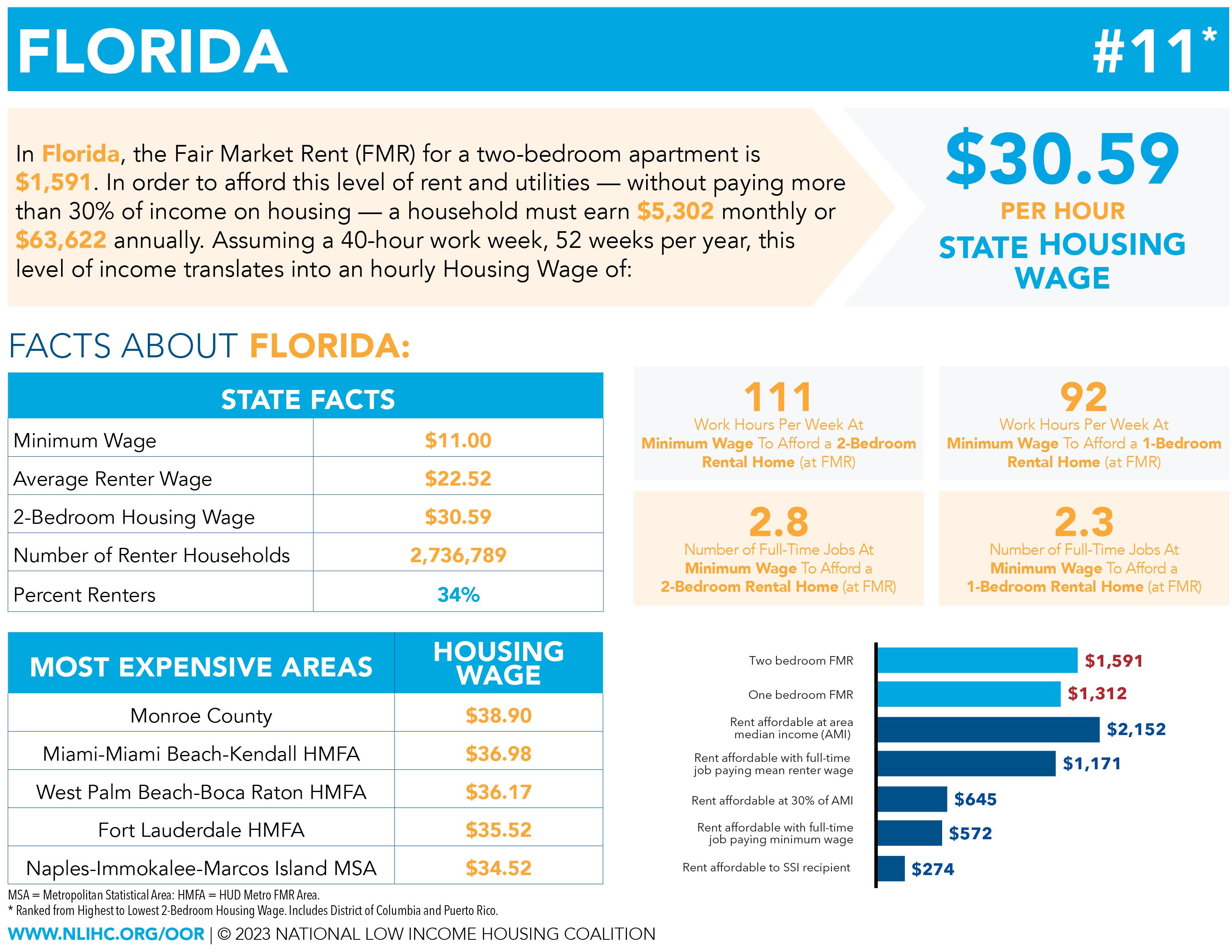
The US Department of Education (ED) requires public school districts to identify children and youth who are homeless during the academic year (including summer school) Children who are doubled up or living in motels due to their family’s loss of housing or economic hardship are defined as

“homeless” by the Florida Department of Education (DoE) and comprise most of the students identified as homeless Note that families living in doubled up situations are not counted as part of the literal homeless population defined by the US Department of Housing and Urban Development (HUD) in the PIT Count each year even though they are considered homeless through DoE DoE reported 63,846 homeless students in the 2021-2022 school year; keep in mind the pandemic impacted this count as well That number increased to 78,277 (18%) in 2022-2023, the last year for which data is available,21 indicating a heightened need for affordable housing for low-income families�
Solving homelessness is possible� Through strategic partnerships, shared goal setting, and coordinated investment planning, every community in Florida can adequately address, reduce, and prevent homelessness Access to affordable housing for every income range is key to solving homelessness in Florida Section 7 provides solutions on how this can be achieved
A REPORT FROM THE FLORIDA HOUSING COALITION FLHOUSING.ORG | THE FLORIDA HOUSING COALITION 7
10
10 THE FLORIDA HOUSING COALITION | FLHOUSING.ORG HOME MATTERS 2023
Florida Homeless Snapshot Scan QR code:
Challenges for Renters


Over 70% of Florida’s low-income renter households are cost burdened,22 and close to 45% of low-income renters are severely cost burdened� Severe cost burden is especially widespread among very low-income renter households (those with incomes <50% AMI)� This section dives into further detail about specific factors that drive high housing cost burdens among lowincome renters


Shortage of Affordable and Available Rental Units
Florida’s communities have rental units – both subsidized and unsubsidized – that are affordable to low-income households However, there are not enough of these units to meet demand, especially in higher-priced metro areas, and higher-income households occupy some of these rentals Low-income renters find themselves in a game of musical chairs for a limited number of affordable units
For extremely low-income households overall, no metropolitan or rural statistical area comes close to providing the number of affordable and available units needed Moving up the income ladder, there is still no area that has enough housing for very low-income households to afford to live there which, in Florida, includes most service workers For low-income households earning 80% AMI, a few areas have enough affordable and available housing, and for households earning 120% AMI, most of the state provides enough units, although there are still serious deficits across South Florida�
Dashboard 5: "Number of Affordable and Available Units per 100 Households” illustrates this shortage of affordable and available units in 2021� For extremely low-income households overall, no metropolitan or rural statistical area comes close to providing the number of affordable and available units needed Moving up the income ladder, there is still no area that has enough housing for very lowincome households to afford to live there which, in Florida, includes most service workers For low-income households earning 80% AMI, a few areas have enough affordable and available housing, and for households earning 120% AMI, most of the state provides enough units, although there are still serious deficits across South Florida
Loss of Affordable Rental Housing
The limited supply of affordable rental housing for lowincome families is constantly shrinking, requiring new affordable homes to be built to maintain supply Owners of rental units subsidized by federal, state, and local funding must keep rents affordable for tenants in certain income brackets for a set period of time, usually 15 to 50 years, depending on the housing subsidy used to finance the units� The units may be lost from the affordable housing stock if the affordability period expires, the owner prepays the mortgage to end the affordability period early, the property is foreclosed on, or (in extremely rare cases) the subsidy is removed due to poor property management
Between 2000 and 2023, Florida lost 65,332 units of subsidized rental housing units from the affordable housing stock 23 The Shimberg Center for Housing Studies has estimated that over 83,687 units are at risk of being lost by 2043, based on the age of the developments, the subsidy source, and the dates when the subsidies will expire� Thankfully, subsidized units are continually being constructed: over 93,000 subsidized units were constructed between 2000 and 2020, although some of them only had 15-year affordability periods and have already been lost
Rising Rents
At the national level, the rental market recovered faster than the homeownership market after the 2008 recession After peaking in 2009, rental vacancies declined to levels not
HOME MATTERS 2023 THE FLORIDA HOUSING COALITION | FLHOUSING.ORG 8
SECTION THREE:
Households Scan QR code: Assisted Housing Units Gained and Lost in Florida Scan QR code: A REPORT FROM THE FLORIDA HOUSING COALITION THE FLORIDA HOUSING COALITION | FLHOUSING.ORG 11
Number of Rental Homes Affordable and Available per 100
seen since the early 2000s As measured by the Consumer Price Index, the nominal value of contract rents (excluding utilities) began to rise in 2010 and outpaced inflation by 2012 This tightening of the national rental market can be attributed to former homeowners entering the rental market after foreclosures 24 Rental trends at the national level are reflected in Florida Since 2010, median gross rent has consistently been higher than rent affordable at Florida’s median renter income The gap between median rents and what the average renter could afford to pay has grown from a low of $177 in 2014 to $230 in 2021, nearly as large as the post-recession high of $243 in 2011� Meanwhile, the state’s overall rental vacancy rate has dropped from a peak of 13 2% in 2009 to 6 8% in 2021 25
Because the ACS lags a few years behind and is less than an ideal source of data for a market that has shifted dramatically in the last few years, it is useful to look at other sources of data that better track 2020 through 2023
The following chart provides a look at rents of 11 MSAs dispersed across Florida and the year-over-year percent change of the average rents across 21 metropolitan areas tracked by the index Consistently across the state, rents have risen by double digits between 2020 and 2022 after nearly a decade of relatively stable rents, reaching a state year-over-year average of as much as 25% with increases in individual MSAs increasing by as much as 40% year-overyear, compared to a state year-over-year average of about 5�5% between January 2015 and January 2020� In other words, during the COVID-19 pandemic, rents rose about five times faster than they were before the pandemic in all of Florida’s major metropolitan areas� In 2023, rent increases have slowed down from their drastic hike, decreasing to a state average rate of 6 9% from May 2022 to May 2023, and individual MSA increases ranging from 2 5% to 19 4%

In many Florida communities, buying a home offers a lower monthly payment than renting and offers better wealth
The Zillow Observed Rents Index (ZORI) tracks MSAs across the state for the observed rents in communities�
creation opportunities if the buyer stays in the home for at least two years However, high rents make it difficult for lowincome households to save for down payment and closing costs 26, 27, 28
A REPORT FROM THE FLORIDA HOUSING COALITION FLHOUSING.ORG | THE FLORIDA HOUSING COALITION 9
Figure 1 - Source: ZORI, 2015-2023
12 HOME MATTERS 2023 12 THE FLORIDA HOUSING COALITION | FLHOUSING.ORG
SECTION FOUR:
Challenges for Homebuyers
Home sale prices vary widely across Florida One key indicator of housing affordability is the National Association of Home Builders’ Housing Opportunity Index (HOI), which looks at the percentage of homes for sale that a medianincome family, assuming a 10% down payment and standard underwriting criteria, could afford In an HOI analysis of 237 MSAs nationwide in the first quarter of 2023, Florida metros ranged from 74th most affordable (Gainesville) to 215th least affordable (Miami-Miami Beach-Kendall, FL) 29 A little more than half of MSAs lost ground nationally, with Port St Lucie, Homosassa Springs, and Cape Coral-Fort Myers experiencing the largest drops in rank�
is slightly higher than the all-time low of 63 8% in 2015 Families losing their homes to foreclosure account for some of this decrease, but the factors discussed below prevent many low- and moderate-income families from buying their first homes�
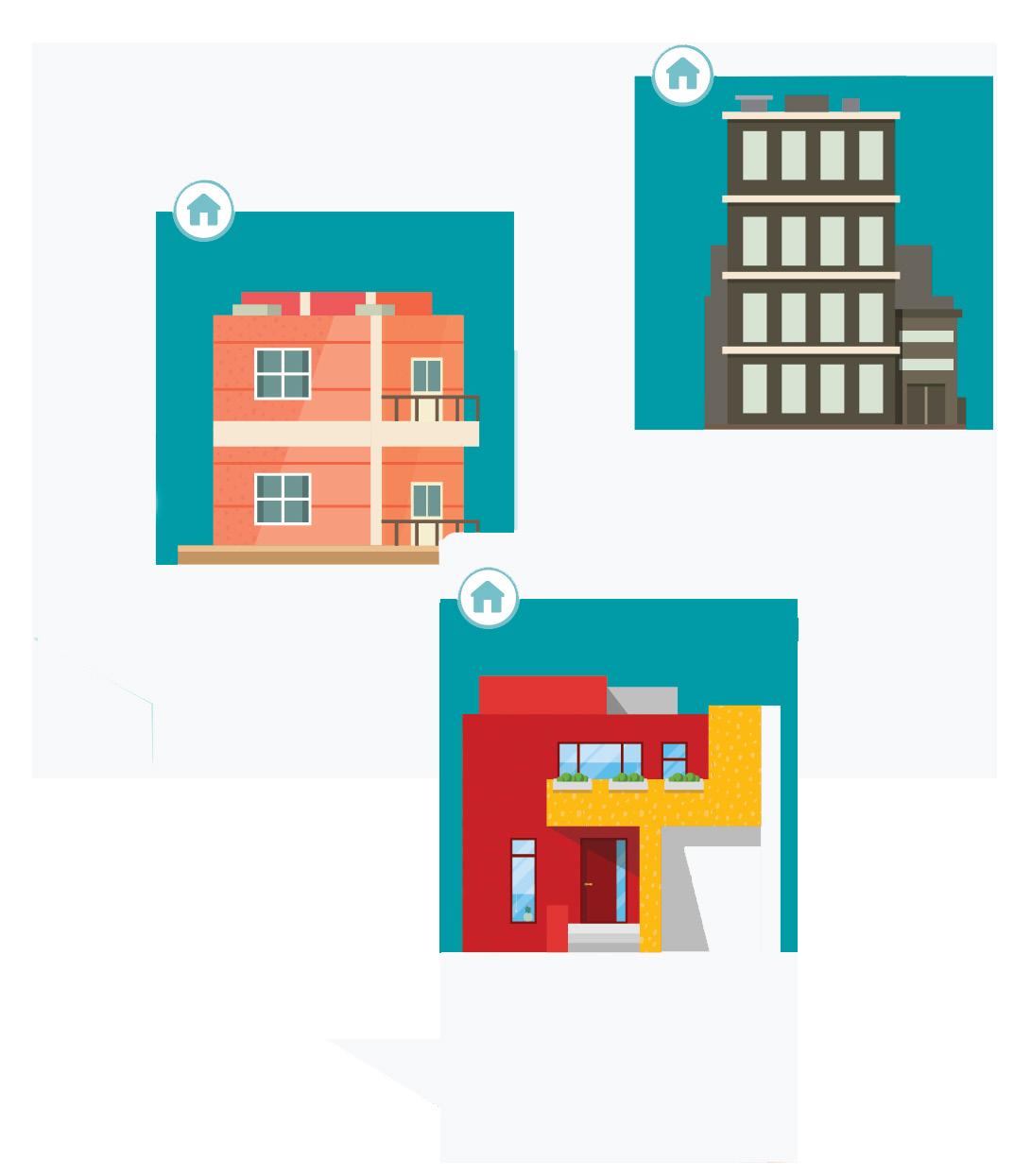

Rising Home Prices
Florida’s homeownership rate has declined steadily from a peak of 70�6% in 2007 to 67�4% in 2021, although this low
Rising Rents in Florida
Jacksonville 2014: $1,100/mo 2023: $1,816/mo
Zillow’s Home Value Index is designed to represent the value of typical properties within a region� Unlike solely considering the homes that have been sold, ZHVI considers the complete distribution of homes in each region, reflecting the typical value for homes in the 35th to 65th percentile range 31 This index provides an extremely up-to-date and accurate measurement of the cost of housing The following chart shows the ZHVI tracked across time from 2001-2023, with the typical home value depicted on the left axis and the year-over-year change tracked on the right axis Tampa 2014:
Daytona Beach 2014: $900/mo 2023: $1,904/mo
Melbourne 2014: $1,100/mo
2023: $2,223/mo
HOME MATTERS 2023 THE FLORIDA HOUSING COALITION | FLHOUSING.ORG 10
Miami Ft.Lauderdale 2014: $1,600/mo 2023: $2,829/mo Orlando 2014: $1,200/mo 2023: $2,092/mo
$1,100/mo 2023: $2,131/mo
13 A REPORT FROM THE FLORIDA HOUSING COALITION THE FLORIDA HOUSING COALITION | FLHOUSING.ORG 13
Source: Zillow Observed Rent Index (ZORI), 2014-2023
Varying Home Prices Across the State of Florida
Deltona-Daytona Beach-Ormond Beach, FL
Lakeland-Winter Haven, FL
North Port-Sarasota-Bradenton, FL
Orlando-Kissimmee-Sanford, FL Cape
Myers, FL
Beach, FL
FL
FL
FL
Since 2012, home prices in Florida have grown steadily from $127,146 in 2012 to $387,537 in 2023 While growth between 2012 and 2020 was slower than the frenzied build-up that preceded the 2008 Great Recession, it has also gone on far longer Because of this slow yet long growth, home prices were already at an all-time high in Florida before the COVID-19 pandemic Homes peaked
at 2 21 times their December 2000 value in 2006, before dropping between 2007 and 2011 After a short pause in home value growth at the beginning of the pandemic, home prices have skyrocketed over the last year and a half, growing dramatically faster than during the build-up to the Great Recession Home prices have risen across the country, but not nearly at the speed Florida homes have been
A REPORT FROM THE FLORIDA HOUSING COALITION FLHOUSING.ORG | THE FLORIDA HOUSING COALITION 11 Affordability Rank Nationally: Q1 2023 Change in Rank Since: Q1 2022 Gainesville, FL Tallahassee,
Sebring-Avon
Homosassa
Jacksonville,
Palm Bay-Melbourne-Titusville,
Tampa-St Petersburg-Clearwater, FL Crestview-Fort Walton Beach-Destin, FL 74 85 102 121 128 133 137 145 149 152 -3 7 -17 34 -7 13 19 21 -8 -27
FL
Park, FL
Springs, FL
FL Pensacola-Ferry Pass-Brent, FL Ocala, FL
FL
Fort Lauderdale-Pompano Beach-Sunrise, FL West Palm Beach-Boca Raton-Boyton Beach, FL Punta Gorda, FL The Villages,
Panama City,
FL
FL
Sebastian-Vero
Naples-Marco
Port St Lucie,
Miami-Miami Beach-Kendall,
159 156 163 166 168 170 175 182 186 187 192 209 197 215 -7 -11 -7 -1 12 10 1 -2 4 26 9 13 47
Coral-Fort
Island,
Not available for 2022
Table 1 Florida MSAs Housing Opportunity Index Rankingw
14 HOME MATTERS 2023 14 THE FLORIDA HOUSING COALITION | FLHOUSING.ORG
appreciating� In the last quarter of 2022 to May 2023, ZHVI home values and year-over-year increases have plateaued and even slightly decreased from their recent peak� While this development offers a glimmer of hope for prospective homebuyers, the housing values are still at a historic peak Consequently, the average homebuyer might not observe any substantial improvement in their purchasing power in the immediate future

Racial Disparities in Homeownership and Housing Instability


Private-sector discrimination in the past was a direct consequence of a partnership between the federal government, local bankers, and real estate brokers and contributed significantly to our residential segregation patterns today Federal housing policy gave official sanction to discriminatory real estate sales and bank lending practices based on the procedure of redlining Through the Home Owners’ Loan Corporation (HOLC), the Federal Home Loan Bank Board developed Residential Security Maps and Surveys used by brokers and lenders to determine eligibility for mortgages and home loans
The maps divided and ranked areas in American cities from A to D with corresponding colors, considering factors such as building conditions; amenities and infrastructure; and –most importantly – the neighborhoods’ racial, ethnic, and economic composition Areas with even small populations of Black Americans were deemed “hazardous” and colored red – hence the term “redlining�”
Florida Typical Home Value
HOME MATTERS 2023 THE FLORIDA HOUSING COALITION | FLHOUSING.ORG 12
Figure 2 - Zillow Home Value Index 2000-May 2023 (Source: Zillow Data Products)
A REPORT FROM THE FLORIDA HOUSING COALITION THE FLORIDA HOUSING COALITION | FLHOUSING.ORG 15
These inequitable practices perpetuated a vicious cycle of neighborhood decline, a legacy that continues to have lingering effects in American cities Most of the neighborhoods the HOLC graded as “hazardous” eight decades ago are low-to-moderate income today, and nearly 64% are still predominately minority neighborhoods 32
This legacy has also had a lingering and moribund impact on financing Black homeownership: The Federal Housing Administration (FHA) regularly refused loans to Black homebuilders while underwriting the construction of homes by whites and refusing to back Black residential development in or near white neighborhoods� To this day, Black homebuyers face difficulties finding high quality financing and are often targeted by predatory lending efforts, including those that led to the subprime mortgage crisis that caused the Great Recession White Floridians are more likely to own a home either free and clear or with a mortgage than any other racial group At the same time, Black Florida families have the lowest homeownership rates in the state, and more than half of households are renters 33
Unfortunately, there have been only small improvements in housing equity over the last 50 years In 1970, two years after the passage of the Fair Housing Act, the African American homeownership rate was 41 6% Black homeownership would rise over the following decades to an all-time high in Florida in 2007 at just over 50% (though it remained 20 percentage points lower than the state as a whole and 30 percentage points lower than white homeownership)� Since 2007, and particularly after the 2008 Great Recession, the Black homeownership rate fell to 43% in 2015, less than 2 points higher than the Black homeownership rate in 1970, when African Americans had only just started being permitted to buy homes in most parts of the US Since 2015,
Age
the homeownership rates for all racial and ethnic groups have grown, with Black homeownership rising to about 49%; Hispanic homeownership at 56%; the other, nonHispanic group (which includes people of multiple races, Native Americans, and Hispanics and Latino who do not identify as Hispanic or Latino) at 64%; Asian non-Hispanic at 73%; and the white homeownership rate at 77%


In 2020, Black and Hispanic households often bore the burden of COVID-19-related housing instability that illuminated and exacerbated existing racial housing disparities According to public opinion polling by Opportunity Starts at Home, 72% of African Americans and 76% of Hispanics expressed concern that they would lose their housing during the pandemic without additional assistance 34
These concerns come on the heels of a decade in which Black Americans continued to trail whites in overall homeownership rates� This lack of ownership coupled with the increasing cost of housing has resulted in significant challenges for Black and Hispanic households in Florida: in 2021, 52% of Blacks and 65% of Hispanics were cost burdened, compared to 34% of whites This cost burden figure increases to more than half of Blacks and Hispanics when looking solely at renters 35
finding high-quality financing

A REPORT FROM THE FLORIDA HOUSING COALITION FLHOUSING.ORG | THE FLORIDA HOUSING COALITION 13
Black homebuyers face difficulties
Black Florida families have the lowest homeownership rates in the state, and more than half of households are renters.
6
HOME MATTERS 2023 16 THE FLORIDA HOUSING COALITION | FLHOUSING.ORG
Home Ownership by Race and
Scan QR code:
This lack of affordable housing exacerbates existing segregation Due to the aforementioned legacy of discrimination, Black families and families of color have lower net wealth and incomes than white families The lower net wealth creates large differences in purchasing power, which, in concert with policies and practices in both the public and private sectors, often results in housing for lowincome households being sited in areas that perpetuate racial residential segregation 36
New Single-Family Home Construction Levels Out While Supply of Inventory Is Up
In 2022, the number of new residential permits in the state leveled off with a 1% reduction in issued permits compared to 2021 which follows a 30% surge the previous year� Despite being the primary source of residential permits, single-family home building permits experienced a significant decline of 10 8% In addition, two-unit buildings fell by 21% Multifamily housing with 5 or more units remained robust in 2022, even though the annual increase in units dropped from a 32% rise from the 2021 permits to just a 22% increase in 2022 While they represent a much smaller proportion of the total units in Florida, buildings with three to four units, namely triplexes and quadraplexes, saw an annual increase of 45%, accounting for 708 units By the end of 2022, the supply inventory for single-family homes was at 2 7 months, and for condos, it was at 2 8 months In comparison, the previous year's levels were 1 0 and 1 3 months, respectively These figures are getting closer to pre-pandemic healthy levels, which typically lie between a three- to five-month supply� This increase in months of supply aligns with a decrease in closed sales through the first quarter of 2023, pointing to a period of moderation of the Florida residential property market and a general cooling trend as interest rates stabilize after rising from historic lows

23 36 74
There are only 23 affordable and available units for every 100 extremely low-income renter households.*
* At or below 30% the area's median income
There are only 36 affordable and available units for every 100 extremely low-income renter households.*
* At or below 50% the area's median income
There are only 74 affordable and available units for every 100 low-income renter households.*

* At or below 80% the area's median income
Number of Units Permitted by Type in Florida
2004-2022
Scan QR code:

HOME MATTERS 2023 THE FLORIDA HOUSING COALITION | FLHOUSING.ORG 14
Attributed to the Shimberg Center
A REPORT FROM THE FLORIDA HOUSING COALITION THE FLORIDA HOUSING COALITION | FLHOUSING.ORG 17
SECTION FIVE:
Resilience and Disaster Recovery
Affordable housing is at risk of damage and destruction from natural disasters like hurricanes, floods, tornadoes, and wildfires Some affordable housing properties, such as older housing and housing located in flood zones, are at a disproportionately high risk of being damaged or lost� Resilience and disaster recovery operate through a continuum of planning and response that housing agencies can incorporate into their operations to save lives, money, and property�
Hurricane Ian
The recent 2022 hurricane season demonstrated the vulnerability of Florida’s affordable housing stock� Hurricane Ian impacted 26 of the state’s 67 counties with where a combined population of 12,197,584 people live, comprising 56% of Florida’s total population There are approximately 5,585,591 housing units across these 26 counties, including 62 9% single-family, 27 8% multifamily, and 9 2% manufactured homes and other housing types Within the 26 disaster-impacted counties, 911,556 valid Federal Emergency Management Agency (FEMA) registrations demonstrate the immense impact of the storm on individuals and families
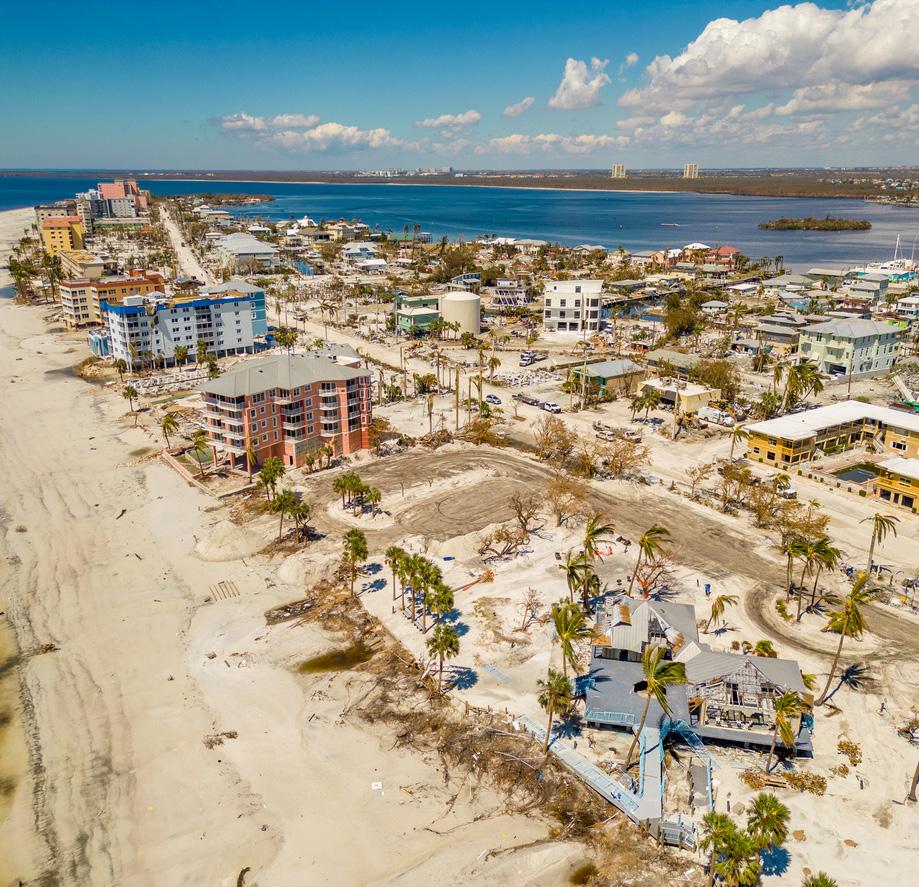
HUD serves as the coordinating agency for FEMA’s Housing Recovery Support Function (RSF) The following data was pulled from the DR-4673-FL DR-4680-FL Housing Impact Assessment prepared by HUD with contributions from FEMA, the State of Florida, and other partners
Damage to homes falls on a spectrum from minor damage to severe/catastrophic damage or destroyed (terms vary depending on the inspecting agency; FEMA, local governments, or the American Red Cross, for example) A total of 3,414 residences were deemed “destroyed” by FEMA inspectors Single family homes, duplexes, and mobile homes comprised 83 6% of the total destroyed residence types
HUD defines FEMA homeowner applicants with “serious damage” as homeowners with a FEMA Real Property inspection of $8,000 or more and/or FEMA Personal Property inspection of $3,500 or more, and/or flooding of one foot or more Further, HUD defines applicants with “unmet needs” as homeowners with serious damage that are not insured for the damage incurred� Of those uninsured owners with serious housing damage and “unmet need” as defined by FEMA, 45�2% of them are owners of a mobile home or travel trailer In Lee County, the epicenter of Hurricane Ian’s impacts, and in the rest of Florida combined, more owners with unmet needs own manufactured homes than the number of owners of single-family homes with unmet needs
A REPORT FROM THE FLORIDA HOUSING COALITION FLHOUSING.ORG | THE FLORIDA HOUSING COALITION 15
Residence Type Count Destroyed % of Total Houses/Duplex 1,756 51.4% 32.2% 5 6% 4 5% 2 8% 2 0% 1�1% 0�4% 0�0% 100% 1,101 191 152 96 68 37 12 1 3,414 Mobile Home Condo Travel Trailer Apartment Other Townhouse Boat Assisted Living Facility Total Table
2� Destroyed Residences by Types for Hurricane Ian
8 HOME MATTERS 2023 18 THE FLORIDA HOUSING COALITION | FLHOUSING.ORG
For individual homeowners and landlords, the first line of defense to repair or replace damaged and destroyed housing is private insurance, followed by Small Business Association Administration (SBA) loans FEMA applicants seeking home repair and replacement assistance from FEMA must demonstrate that they did not receive enough funding from these two sources to cover demonstrable costs to receive funds� Homeowners, landlords, and renters without insurance coverage or the ability to secure an SBA loan to cover the partial or full cost of damage remediation rely on FEMA and Florida Division of Emergency Management (FDEM) programs, HUD
costs are Lee, Charlotte, Volusia, Sarasota, Collier, Orange, DeSoto, and Polk The total FVL is comprised of the county’s real property loss (dwellings), and personal property loss (other living expenses such as personal vehicles, moving, and storage expenses)�
For Hurricane Ian, out of 400,811 SBA loan applicants, 322,862 applicants (80�6%) failed the income test to qualify� A failed income test (FIT) is the result of the applicant’s income being too low Furthermore, 63 5% of FEMA applicants had no form of homeowners or renters insurance coverage (155,723 owners without home insurance, 421,920 renters
Community Development Block Grant Disaster Relief (CDBGDR) funds, state-allocated disaster funds such as SHIP Disaster Recovery (SHIP-DR) and Hurricane Housing Recovery Program (HHRP) funds, philanthropic funds, and other sources to make their homes habitable
The counties with the highest FEMA verified loss
without renters insurance, and 1,026 without insurance and unknown tenure), and 90�1% of applicants had no form of flood insurance coverage (407,607 owners, 413,985 renters, 1,337 unknown)
A total of 21,259 homes rented by very low-income residents with serious unmet housing needs experienced serious
HOME MATTERS 2023 THE FLORIDA HOUSING COALITION | FLHOUSING.ORG 16 Lee County Volusia County Charlotte County Orange County Sarasota County Florida Remainder Total Multi-Family (Apartment or Condo) Single-Family (House, Duplex, or Townhouse) Manufactured Home (Mobile Home or Travel Trailer) Other (Boat or Other) Total 864 84 95 94 77 255 1,469 5,177 3,080 1,921 1,906 1,876 6,258 20,218 6�232 1,817 1,358 621 1,591 6,595 18,214 141 32 42 1 16 166 398 12,414 5,013 3,416 2,622 3,560 13,274 40,299
Table 3 Uninsured Owner with Serious Damage and Unmet Housing Needs by Housing Type and Tenure
(FVL) County Total FVL HUD Serious Unmet Housing Need Estimates Number of Applicants FEMA Inspected DamageNumber of Dwellings Lee Charlotte Volusia Sarasota Collier Orange DeSoto Polk $1,043,184,883 $140,044,879 $99,689,812 $94,614,653 $69,927,086 $43,771,369 $27,265,457 $21,469,965 31,037 9,482 8,016 7,808 3,626 4,439 1,916 3,440 9,824 2,907 3,519 1,966 1,649 3,747 649 1,843 13,076 3,274 4,386 2,876 1,915 2,811 969 1,247 Owner Renter
Table 4 Most Impacted Counties by FVL, FEMA Inspected Damage, and HUD Serious Unmet Housing Need
A REPORT FROM THE FLORIDA HOUSING COALITION THE FLORIDA HOUSING COALITION | FLHOUSING.ORG 19
housing damage, with the majority of those living in a singlefamily home or duplex (10,262 homes) or an apartment (7,020 homes) Congruent with FVL of destroyed residence types, single-family houses, duplexes, and townhouses suffered the most damage, representing approximately 50% of the very low-income renter housing type with damage
Impacted Publicly Assisted Housing
There are a total of 508 HUD multi-family housing properties across the 26 disaster-impacted counties� These either have an FHA-insured mortgage, ProjectBased Rental Assistance, deed restriction covenants (use agreement), or a combination of these business agreements Of these, 30 91% of the properties sustained some level of damage For additional context, there are also 49 Public Housing Authorities (PHA) supporting 9,259 public housing households and approximately 47,375 housing choice voucher (HCV) households HUD multi-family housing inspectors reported 264 of the 508 HUD properties (52%) incurred some level of damage, including 14 properties with severe damage, resulting in
144 households being displaced The total assessed repair cost for these properties is $22,348,146 An additional 89 households utilizing HCVs were displaced for a total of 243 displacements
The area with the most HCV displacements is New Smyrna Beach with 37 displacements The PHA with the most damage is Daytona Beach Housing Authority with 100 units damaged and 89 displacements� The area with the second most HCV displacements was Daytona Beach with 17 displacements, and the PHA with the second most damage is New Smyrna Beach PHA with 38 units damaged and 38 displaced Finally, the areas with the third most HCV displacements are Fort Myers and Orange County with 8 displacements each, and the PHA with the third most damage is the Fort Myers PHA with 20 units damaged and 22 displaced households
The Florida Housing Finance Corporation (FHFC) reported 334 developments in their portfolio (including 1,304 damaged buildings) with some level of damage, including 12 developments with extensive damage and 2 developments with catastrophic damage, displacing 132 households
Impacted Underserved Households
Southwest Florida, where the worst of the destruction occurred, is known as the retirement belt of the state
The Florida average for residents aged 60 and older is approximately 27%, and of the 26 declared counties, 18 exceed that average (Brevard, Charlotte, Collier, Desoto, Flagler, Glades, Highlands, Lake, Lee, Manatee, Monroe, Palm Beach, Pasco, Pinellas, Putnam, Sarasota, St� Johns,
A REPORT FROM THE FLORIDA HOUSING COALITION FLHOUSING.ORG | THE FLORIDA HOUSING COALITION 17
Lee County Volusia County Charlotte County Orange County Sarasota County Florida Remainder Total 1,631 873 319 1,287 184 2,726 7,020 205 39 25 80 9 135 493 2,722 1,054 673 1,150 823 3,840 10,262 86 96 1 86 15 148 432 659 136 134 97 100 1,037 2,163 99 30 12 10 10 165 326 19 1 27 29 98 81 37 66 21 231 534 5,519 2,310 1,203 2,776 1,162 8,289 21,259 Apartment Condo House/ Duplex Townhouse Mobile Home Travel Trailor Boat Other Total Multi-Family Single-Family Manufactured Housing Other
Table 5� Serious Unmet Housing Need for Very Low-Income Renters for Hurricane Ian
Damage Level 0=No Damage Grand Total 1=Minor Damage 2=Moderate Damage 3=Severe Damage 6=No Assessment, unoccupied in Production Pipeline Number of Properties Total Units Assisted Units 297 106 37 14 54 508 30,395 12,145 5,323 1,766 908 50,537 13,579 4,394 1,586 872 192 20,623 20 HOME MATTERS 2023 20 THE FLORIDA HOUSING COALITION | FLHOUSING.ORG
Table 6 HUD Multi-family Housing Program Property Damage for Hurricane Ian
and Volusia)� Charlotte County and Sarasota County have the highest population of residents age 60 or older, with 47% and 44% respectively Approximately 59 9% of homeowners and 22 01% of renters registered with FEMA after the storm were aged 60 and over
Older adults and people with disabilities have particularly challenging housing needs and are incredibly disproportionately vulnerable to displacement, contractor scams, and even death FEMA refers to people with disabilities as having “access and functional needs” (AFN) According to State medical examiner data, nearly two-thirds of the fatalities caused by Hurricane Ian were people over the age of 60, many of whom drowned in their flooded homes while others suffered the fatal impacts of losing power to their homes
It is important to note that Non-Hispanic/Latino white households with serious unmet needs are mostly owners (74% of owners, 54% of renters), while all Non-white households with serious unmet needs are mostly renters; Black residents with serious unmet needs have a particularly high difference in owners versus renters (6% of owners, 19% of renters)
Resilience and Disaster Planning
Planning helps ensure strategic and successful use of resources and regulations to accomplish desired aims of housing production This section looks at examples from resiliency and disaster recovery planning with regards to data analysis in the housing planning process and community/stakeholder engagement and coordination to ensure safe, resilient housing for all Floridians
*Estimates provided by HUD by applying number of cases in 2020 Census blocks to a proportionate percentage of people in each race/ethnic group in that Census block and adding the percentages
**American Indian/Alaska Native
Analytical Inputs
Housing needs assessments and action plans analyzing metrics such as those shown in this report are a typical starting point for communities to guide investment of resources and policy/regulatory needs This analysis
HOME MATTERS 2023 THE FLORIDA HOUSING COALITION | FLHOUSING.ORG 18
Owners FEMA Registrants HH with Member 60+ % 60+ Registrants HH with AFN % AFN Registrants Renters 476,987 421,727 285,947 93,052 59�9% 22 0% 103,024 67,494 21�6% 16 0%
Table 7 FEMA Registrants 60+ and with Access and Functional Needs (AFN) in Florida Post-Hurricane Ian
Table 8 Estimates* of Serious Unmet Needs by Race and Tenure for Hurricane Ian
Owner Serious Unmet Needs Renter Serious Unmet Needs Households with Serious Unmet Needs all of Florids White White Black AIAN** Asian Hawaiin or Pacific Islander Other or multirace NonWhite Hispanic/Latino Non-Hispanic/Latino 23,106 3% 5% 17% 54% 19% 0% 1% 0% 4% 11% 74% 6% 0% 1% 0% 3% 12,977 A REPORT FROM THE FLORIDA HOUSING COALITION THE FLORIDA HOUSING COALITION | FLHOUSING.ORG 21
provides key insights such as how much housing needs to be built, housing needs of specific populations, and how that might evolve with changing circumstances such as population growth This analysis should include quantitative and qualitative data
An imperative factor to incorporate at the planning stage is a vulnerability assessment to account for resilient housing and successful recovery after a disaster, particularly for housing for vulnerable populations such as lower income households and older adults� Many tools assess housing vulnerability, from the regional and communitywide scale to the building scale FEMA’s National Risk Index provides an overview of natural hazard risks at the county level 37 The Housing Coastal Flood Hazard Exposure tool38 developed by the University of Florida’s Shimberg Center for Housing Studies is a regional vulnerability assessment tool that overlays three key elements:
• Geographic location of threats: historical and potential risks and hazards, such as flood hazard, storm surge, windborne debris area, and heat
• Geographic location of people: socially vulnerable populations; can use the CDC’s Social Vulnerability Index
Resilience planning can save an exponential amount of money over time.
A FEMA study found that for every one dollar invested in flood mitigation, six dollars are saved on recovery.
Once vulnerable addresses have been identified, a vulnerability analysis can be performed of individual structures and buildings Enterprise Community Partners’ Portfolio Protect tool (deployed through the Keep Safe Florida program), RiskFactor by the Streetlight Foundation, and HazardAware can identify specific risks faced by individual properties The Portfolio Protect tool is a fully customized property survey that helps building owners, operators, and developers understand which properties are at highest risk from natural disasters� The other two resources are easily accessible websites where information is generated for any searched address
• Geographic location of housing: assisted living facilities, affordable housing properties, and naturally occurring (lower cost) affordable housing such as mobile homes
Engagement & Coordination
Successful housing efforts require committed stakeholders ready to work together to increase production of housing
Key Considerations for Local Housing Strategies
a Deep Affordability & Long-Term Assurances: Address housing affordability by considering all housing-burdened and homeless individuals Ensure housing remains affordable for the long term via community land trusts, ground leases or other legal means
aEquity: Recognize the historical impact of discriminatory practices in homeownership and lending� Ensure fairness in housing by enforcing existing laws and aadopting additional measures to address discrimination and create equal housing opportunities for all individuals�
aResiliency & Disaster Response: Assess vulnerabilities and implement resilient housing plans that include mitigation and disaster response with special attention to vulnerable
populations, including older adults and lowincome households�
aAccess to Services, Amenities & Opportunities: Ensure affordable housing comes with access to necessary services, amenities, and opportunities such as transportation, jobs, healthcare, and food Implement housing first and permanent supportive housing strategies to help those experiencing homelessness
aPartnerships, Education, Engagement & Advocacy: Coordinate across stakeholders, programs, and funding sources in the production of affordable housing; inclusively engage with underrepresented groups Use data to build shared understanding and direct efforts�
A REPORT FROM THE FLORIDA HOUSING COALITION FLHOUSING.ORG | THE FLORIDA HOUSING COALITION 19
22
Figure 3 - Cross Cutting Aims for Best Practices in Affordable Housing Production
HOME MATTERS 2023 22 THE FLORIDA HOUSING COALITION | FLHOUSING.ORG
that is affordable and meet community housing needs

Florida’s Disaster Housing Task Force (DHTF) provides a best practice example from the realm of post-disaster housing recovery The Florida Housing Coalition partnered with FDEM to facilitate the state-led DHTF in the immediate aftermath of Hurricane Ian� This task force has been part of a groundbreaking approach to addressing post-disaster housing for hurricane survivors through coordination of housing providers, social services providers, and Emergency Management, making Florida a leader in the nation for housing recovery With over 150 member stakeholders at the federal, state, and local level, the DHTF hosted weekly check-in meetings as early as three weeks after Hurricane Ian made landfall Members exchanged real-time updates about housing funding and programs directly from state and federal team leads, and solved problems for immediate survivor needs with local service providers All staff meetings of the DHTF are recorded and posted on our FLHousing org Disaster Page 42
SECTION SIX: Solutions
Across the state, organizations and communities are implementing best practices to build and preserve affordable housing Underlying these practices are one or more cross-cutting aims (Figure 3) that serve as strategic objectives spanning multiple aspects of housing production These aims do not exist in isolation; instead, they weave together different areas of focus to create a holistic approach to problem-solving� This section highlights a selection of efforts and initiatives in place and developing to address the ongoing affordable housing crisis�

LAND Permanent Affordability and Community Land Trusts
Permanent affordability through subsidy retention models is a key solution to both producing and preserving housing affordability in Florida Permanent affordability seeks to

Community Land TrustsThroughout Florida
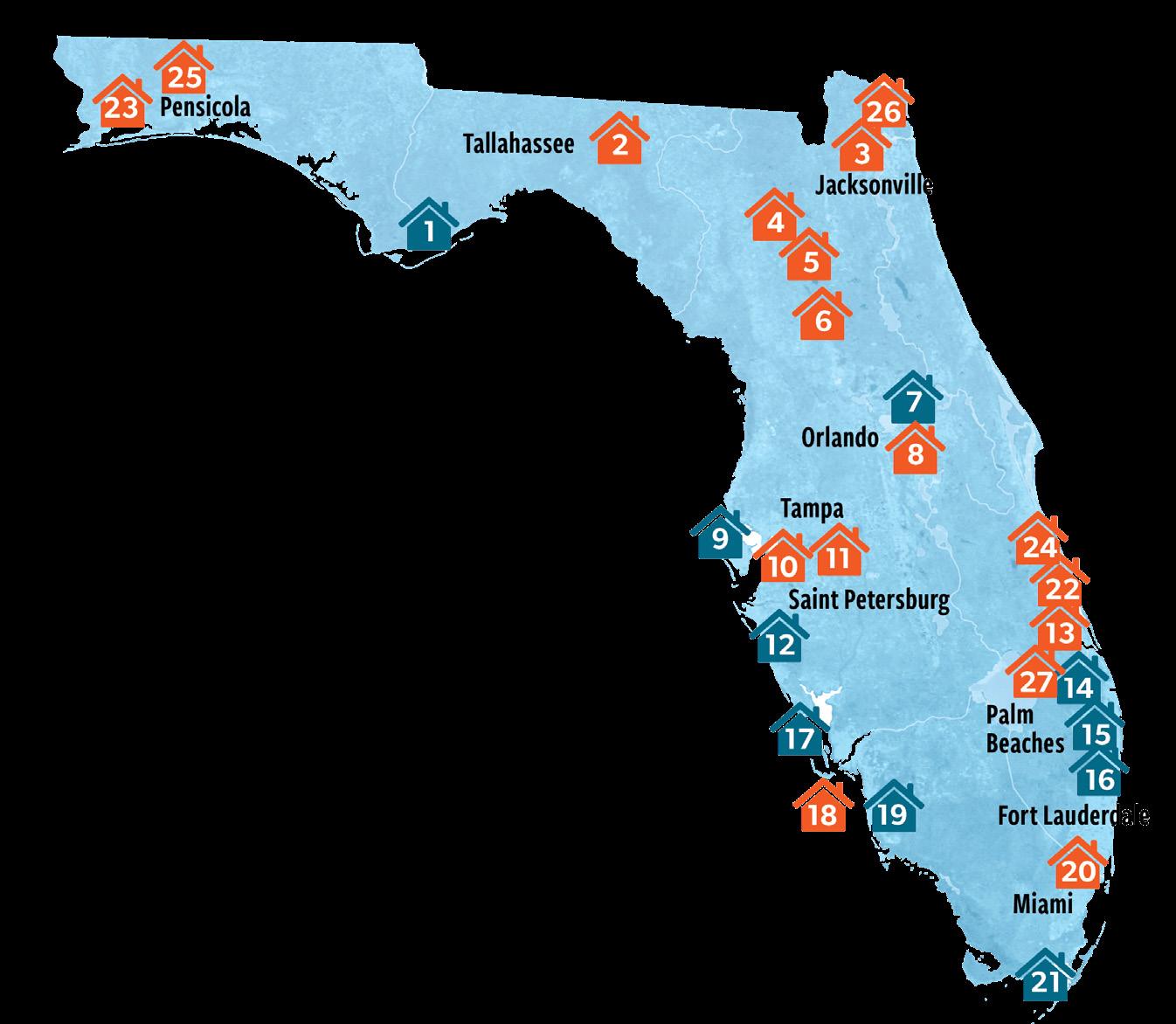
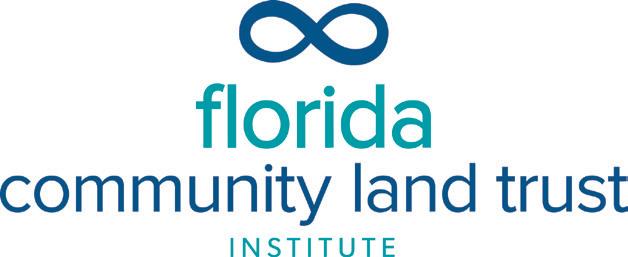
HOME MATTERS 2023 THE FLORIDA HOUSING COALITION | FLHOUSING.ORG 20
23
A REPORT FROM THE FLORIDA HOUSING COALITION THE FLORIDA HOUSING COALITION | FLHOUSING.ORG 23
Newly Formed or Organizing
remove housing produced with public subsidies from the speculative market and preserve it forever as a community asset Historically, local governments have utilized a subsidy recapture approach When applied to homeownership, funds, provided as purchase assistance for example, are repaid when a home is sold then used to assist other eligible households Similarly for rental housing development, funds are typically provided in the form of a recapturable (though forgivable) deferred payment loan with an expiring affordability period� Recapturing funds serves to increase revenue, as annual SHIP allocations alone cannot meet the growing need� However, this approach is ineffective in addressing the growing affordability gap and adding to the limited supply of affordable housing over time
Alternatively, a subsidy retention approach involves a one-time investment to produce a housing unit initially, then permanently maintain affordability through legal agreements that determine resale price or rent as well as the income eligibility of households that can buy or rent the unit These restrictions keep the housing perpetually affordable to homebuyers or renters at the same income level Specifically for homeownership, several home buyers can benefit from a single investment of subsidy generation after generation The house is not lost to the open market after it is sold and remains forever in the affordable housing
inventory In this way, the value of the one-time subsidy grows rather than diminishes in value due to rising costs of production, sales prices, and rents which far outpaces the growth in household incomes in most communities
The most powerful form of subsidy retention is the community land trust (CLT) model A CLT refers to the legal vehicle of separating land from building (house) for the purpose of transferring title to dwelling units without selling the land underneath It also denotes the non-profit corporation that acquires and holds title to the land and manages the ground leases on that property for the benefit of that community
Many communities are looking to the community land trust model as their preferred strategy to achieve permanent affordability Dashboard 9: "CLTs in Florida” below illustrates the locations of active community land trusts in the state, their service areas, and the locations of existing units within a CLT While CLTs throughout Florida have focused primarily on homeownership, a growing number of local governments are also supporting permanent affordability for rental housing in partnership with a CLT Doing so has the double benefit of increasing the number of affordable rental units while building the capacity of a nonprofit whose mission also involves the production and preservation of affordable housing for homeownership
Florida is a national leader in growth of CLTs and is the first in the nation to have a certification program. When a CLT is certified by the Florida Housing Coalition’s CLT Institute, local governments, lenders, and home buyers can be confident that CLT is using best practices for general operations and for stewardship.
If you are a nonprofit or local government interested in a community land trust, please contact the Florida Housing Coalition. We have the entire suite of education, technical assistance, and documentation you need.



Scan QR code:

A REPORT FROM THE FLORIDA HOUSING COALITION FLHOUSING.ORG | THE FLORIDA HOUSING COALITION 21
EQUITY
24
Florida
Community Land Trusts Work
Across
HOME MATTERS 2023 24 THE FLORIDA HOUSING COALITION | FLHOUSING.ORG
Surplus Land
Utilizing publicly owned land for affordable housing purposes is one of the most vital tools local governments have to address the state’s affordable housing crisis All parcels the local government owns in fee simple that can be developed for residential purposes should be placed on the inventory� If it is appropriate for market-rate housing, it is appropriate for affordable housing The Live Local Act amended Florida’s “surplus land” laws to increase accountability and transparency in dedicating and using more public land for these purposes These statutes, found at s� 125�379 and 166�0451 for counties and cities respectively, require local governments to identify parcels they own in fee simple that are “appropriate for use as affordable housing ” Parcels identified as “appropriate” for affordable housing must be placed on a local affordable housing inventory list and adopted by the city or county commission via a resolution� Parcels placed on the inventory list can then be used for a variety of affordable housing purposes
The Live Local Act extends this affordable housing inventory requirement to include all dependent special districts, which includes entities such as Community Redevelopment Agencies, and requires local governments to now post this inventory list online to encourage potential development The Act also encourages local governments
to utilize best practices when using publicly owned land for affordable housing These changes to state law can help local advocates and developers have their communities devote more publicly owned land to address the state’s housing crisis�
Public Funding Programs
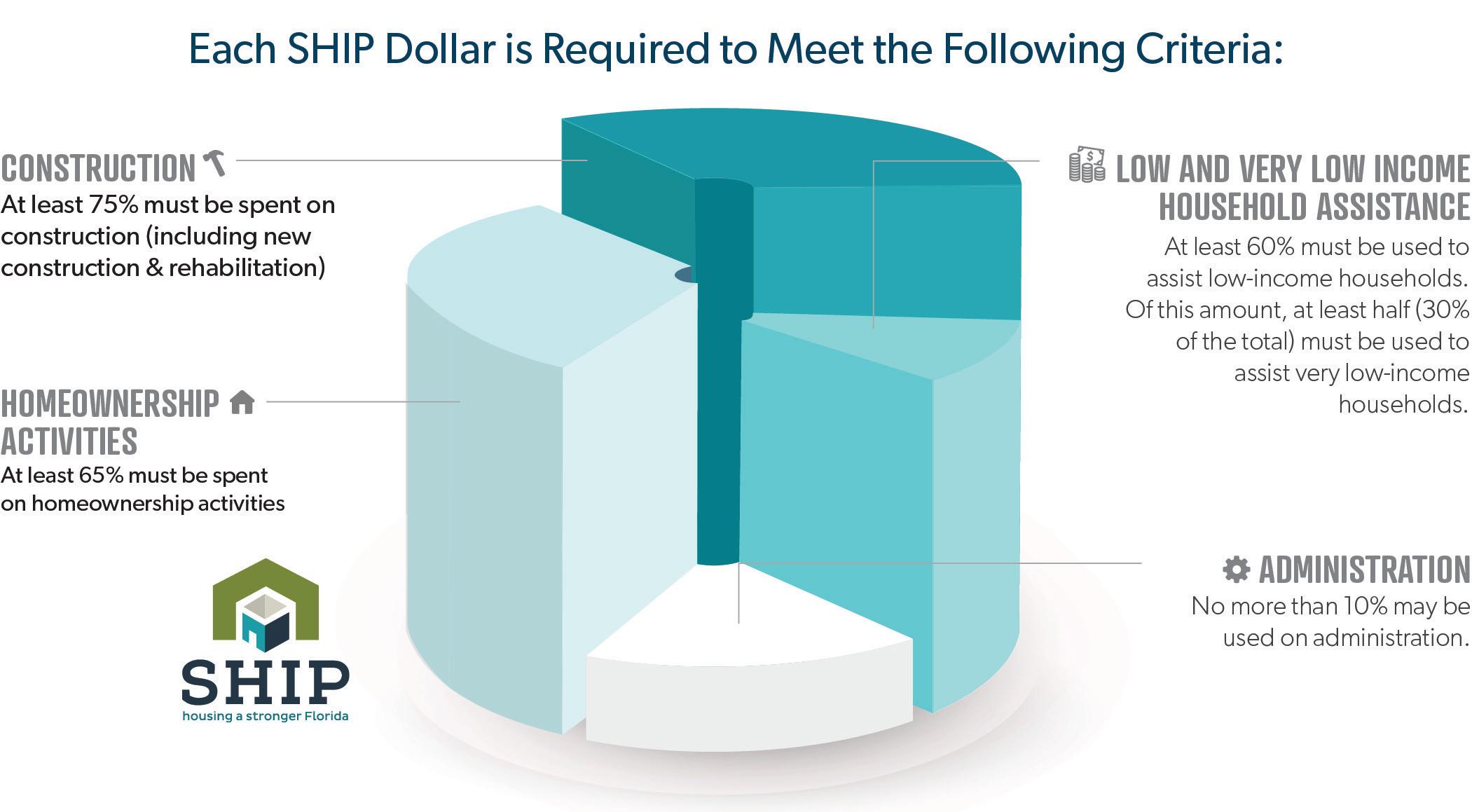
Public funding in coordination with private funding and financing tools is a critical resource to increase deeply affordable units for the long term This section details recent highlights and success stories from federal, state, and local programs� Lending requirements and practices at the federal level and for private lending institutions can also be monitored for additional opportunities to finance housing that is affordable
Federal
Federal funding programs are a significant source of revenue for affordable housing The federal Low Income Housing Tax Credit (LIHTC) program, for example, is the nation’s most successful program at producing affordable rental housing A recent study by the Urban Institute found that LIHTC financed 18% of all new multi-family housing development in Florida from 2000-2019 Federal funding programs are numerous and varied enough that an exhaustive list with program details is not included here Yet generally, they include support in the form of tax
HOME MATTERS 2023 THE FLORIDA HOUSING COALITION | FLHOUSING.ORG 22
A REPORT FROM THE FLORIDA HOUSING COALITION THE FLORIDA HOUSING COALITION | FLHOUSING.ORG 25
credits, assistance to residents, assistance to developers, assistance to governments and service providers, and more to further affordable housing with programs that focus on specific topics and/or specific groups (e�g�, USDA Multi-family direct loans to assist with rental housing for low-income, older adult, or disabled individuals and families in eligible rural areas and Continuum of Care to assist people experiencing homelessness)
Federal funding increases were key in a huge win towards ending homelessness in Charlotte County, Florida
communities in the nation and the first in Florida to reach this monumental goal
STATE Sadowski Trust Funds & Impact of the Live Local Act
The William E Sadowski Affordable Housing Act, passed in 1992 thanks to a non-partisan coalition of eleven statewide organizations called the Sadowski Coalition, created a statewide dedicated revenue stream for affordable housing Today, the Sadowski Coalition proudly consists of over 40 statewide organizations who have made fully funding our state’s affordable housing programs a priority
SADOWSKI HOUSING COALITION MEMBERS

ADVOCATES FOR THE ELDERLY/ VETS/ HOMELESS/ SPECIAL NEEDS
The Sadowski Act created two trust funds: the Local Government Housing Trust Fund and the State Housing Trust Fund The trust funds are replenished annually by a percentage of the state’s documentary stamp tax collections� The collections are allocated by a 70%/30% split between the local and state housing trusts, respectively, according to a formula in state statute Because monies collected in these two affordable housing trust funds are tied to the documentary stamp tax, a tax assessed on real estate transactions, the hotter the real estate market, the more money is collected for affordable housing
GOVERNMENT/ PLANNING ORGANIZATIONS
Associated Industries of Florida
Coalition of Affordable Housing
Providers
Federation of Manufactured Home of Florida
Apartment Association
Bankers Association
Chamber of Commerce
Green Building Coalition
CoCs saw an infusion of funding related to response to the pandemic in 2020, 2021, and 2022, including additional federal resources known as Emergency Solutions Grant (ESG) to address homelessness prevention, street outreach, rapid rehousing, and emergency shelter needs� Some communities across Florida struggled with the capacity to administer multimillions in increased funding, while others got creative and used these resources in nontraditional ways The homeless CoC operating in Charlotte County and led by Gulf Coast Partnership used their increase in funding to place their most vulnerable homeless community members into permanent housing through ESG-funded Rapid Rehousing programs Many of these individuals had higher needs associated with sustaining housing and were not thought to be successful in the long term unless they were taking advantage of a Permanent Support Housing Program This community used ESG to fund case management and financial assistance and relied on other community partners to step in and support residents with higher service needs to sustain their housing They made the rapid rehousing funds they had access to available to serve the highest need and the most difficult to house Today, they are celebrating, as a community, ending chronic homelessness under the requirements laid out in the federal criteria and benchmarks through the United States Interagency Council on Homelessness� Criteria and Benchmark for Achieving the Goal of Ending Chronic Homelessness | United States Interagency Council on Homelessness (USICH) They are one of five
BUSINESS/ INDUSTRY GROUPS
• AARP of Florida
• Florida Association of Centers for Independent Living
• Florida Association of Housing and Redevelopment Officials
• Florida Coalition to End Homelessness
• Florida Housing Coalition
• Florida Legal Services
The Sadowski Trust Funds primarily support two statewide programs for affordable housing: the SHIP and SAIL programs SHIP, which is funded by the Local Government Housing Trust Fund, is administered by FHFC and deploys funding to 67 counties and 55 cities for local affordable housing initiatives based on population SHIP is flexible in that local governments can use the funds for both rental and homeownership and for a broad variety of activities such as down payment and closing cost assistance, new construction, rehabilitation, home repair, rental and mortgage assistance, insurance deductibles, and more
• American Planning Assoc., Fla.
• Florida Association of Counties
• Florida Association of Local Housing Finance Authorities
• Florida Housing Finance Corporation
• Florida League of Cities
• Florida Redevelopment Association
• Florida Regional Councils Association
• 1000 Friends of Florida
SHIP dollars are a great way to support new workforce housing construction and to preserve our state’s existing affordable housing stock� For example, SHIP can both help older low-income adults age in place through home repairs
BUSINESS/ INDUSTRY GROUPS FAITH BASED ORGANIZATIONS
ADVOCATES FOR THE ELDERLY/ VETS/ HOMELESS/ SPECIAL NEEDS
A REPORT FROM THE FLORIDA HOUSING COALITION FLHOUSING.ORG | THE FLORIDA HOUSING COALITION 23
26 HOME MATTERS 2023 26 THE FLORIDA HOUSING COALITION | FLHOUSING.ORG
and renovations and fund repairs to affordable multi-family rental housing
SAIL is Florida’s affordable rental housing program and is funded by the State Housing Trust Fund� Administered by FHFC, SAIL provides low-interest loans on a competitive basis to affordable housing developers often to bridge the gap between the development’s primary financing and total cost of development SAIL is a proven national model for financially supporting the development of affordable rental homes
Although SHIP and SAIL are proven to be successful at building and preserving our workforce housing stock, the Legislature had a history of sweeping funds collected in the Sadowski Trust Funds to other purposes and not the affordable housing programs they were designed to support In the 20-year period from 2001 to 2021, the Legislature swept over $2 2 billion from the Sadowski Housing Trust Funds to other purposes; that is over 166,000 affordable units that were not assisted because of the “sweeps ” Fortunately, we are in a new era as Senate Bill 2512 from the 2021 Legislative Session “stopped the sweeps” by codifying into law that the monies collected in the State and Local Government Housing Trust Funds may not be diverted to General Revenue (after permanently reducing the monies allocated to the Trust Funds by 50%)
In 2023, housing advocates saw the third legislative session in a row where the Legislature fully funded the core Sadowski Housing Trust Fund programs This was due to the passage of the Live Local Act , the most impactful piece of housing legislation since the passage of the Sadowski Act In addition to containing various land use, property tax, and other policies aimed at building more affordable housing, the Live Local Act fully funded the SHIP and SAIL programs�
Through the Act, the Legislature appropriated $511 million for housing programs supported by the Sadowski State and Local Government Housing Trust Funds for the 2023-2024fiscal year $252 million was appropriated for the SHIP program, $109 million for SAIL, and $150 million for a SAIL-like program aimed at building more affordable
rental units within certain statutory parameters The Act also funded the Hometown Hero Housing Program, a down payment and closing cost assistance program to full-time employees of Florida-based businesses, at $100 million and created a brand-new Tax Donation Program where corporations can lower their corporate tax and insurance premium tax liability in exchange for donating money directly to the SAIL program
After including the additional housing projects supported by General Revenue, the Legislature appropriated well over $1 billion in total for housing This is largely due to the work of the Sadowski Coalition, Sadowski Affiliates, and all those who worked to include language in Senate Bill 2512 from the 2021 Legislative Session, which codified into law that all monies collected in the State and Local Government Housing Trust Funds be used for housing
Every dollar spent from the Sadowski Trust Funds will leverage $4 to $6 from other private and public sources; when the total impacts are considered, the total economic benefit equates to about $7 2 billion Additionally, the creation or renovation of affordable housing units will create more than 56,000 jobs�
Since program inception in FY 1992-1993, over $2�6 billion in SHIP and HHRP funding has been appropriated and allocated, leveraging more than $8 8 billion and financing over 207,000 housing units Likewise, over $1 2 billion has been allocated to SAIL and Homeownership through the Florida Housing Assistance Program (HAP) since inception, resulting in 75,749 and 30,294 total units financed, respectively Between these programs, over 310,000 units were financed from inception to FY 2018-2019 However, $2 2 billion has been swept from the Sadowski Trust Funds since inception, meaning that over 166,000 units were not produced Until recently, the failure to appropriate Sadowski funds for housing was a longstanding statewide issue that had real-life consequences for Florida households Moving forward, it is the hope of Sadowski advocates that the Live Local Act represents a new era for how the state addresses affordable housing funding
HOME MATTERS 2023 THE FLORIDA HOUSING COALITION | FLHOUSING.ORG 24
A REPORT FROM THE FLORIDA HOUSING COALITION THE FLORIDA HOUSING COALITION | FLHOUSING.ORG 27
It is the hope of Sadowski advocates that the Live Local Act represents a new era for how the state addresses affordable housing funding
Funding to End Homelessness
In addition to the Live Local Act, the 2023 legislative season yielded unprecedented increases in state funding for homeless services and homeless service system capacity through a $2,205,056 increase in Staffing Grant and $11,819,157 in Challenge Grant funding� Combined, the increased recurring funding dedicated to homelessness from the state will increase by 3 5 times from $6,181,500 to $22,040,378 starting in 2024 The horizon is looking bright for those Florida families and individuals that may fall on difficult times and be facing homelessness, through more access to affordable housing and service supports�
Local
In addition to the federal and state public resources for affordable housing, local governments are also opting to focus local revenues and financing mechanisms towards increasing affordable housing and related efforts A typical approach is creating an affordable housing trust fund for local revenues to be used for a variety of affordable housing activities such as new construction, rehabilitation, down payment assistance, and rental assistance Examples of local revenue sources used for affordable housing include general revenue, tax increment financing, the infrastructure surtax, municipal services taxing units, inclusionary housing in-lieu fees, and publicly owned property sale proceeds Note that certain revenues may have conditions in terms of their adoption and use to fund affordable housing or related needs (e g , infrastructure) Forms of funding and financing support include grants, loans, and bonds�
Land Use Policies & Development Regulations
The impact of local zoning and land development regulations on housing affordability is a hot topic across Florida More and more communities are looking to their own local policies and grappling with the impact of their regulations on the supply of housing � Zoning and land use policies can impact the
1) cost of development, 2) number of housing units that can be legally produced, 3) types of housing allowed, 4) location of different uses, 5) infrastructure capacity of new development, and 6) willingness of the private sector to produce affordable homes
Solutions in this category span changes to policies and regulations for by-right development allowances, incentives to encourage affordable housing, and requirements to build affordable housing� Policies and regulations include those regulating site design, as well as financial and procedural considerations for development
Zoning Reform
Zoning reforms to remove barriers to building more homes have been sweeping the nation in recent years, including zoning standards enacted at the state level Key reforms include allowing different types of housing other than the traditional single-family home by-right, reducing setback and minimum lot size requirements, reducing parking requirements, reducing the number of discretionary review processes, and addressing regulations generally that either increase cost of development or lower the number of homes that can be built� Housing type reforms, for example, include allowing and promoting more multifamily residential and mixed-use development; small-scale multi-family residential such as duplexes, triplexes, and townhomes; and accessory dwelling units (ADUs, see Figure 3)� Additional reforms accompanying increased housing type allowances include increasing density and floor area ratio allowances and land development regulations that affect what can feasibly be built on a site, such as off-site parking, buffer, setback, and other site design requirements� Zoning reforms to facilitate the production of more housing can also include regulations for resiliency such as flood mitigation standards for buildings or locational regulations to guide development towards less vulnerable areas
Palm Beach County Housing Bond
In November of 2022, Palm Beach County voters approved a $200 million dollar bond for affordable housing� The bond will help create rental and homeownership opportunities for households earning up to 140% of the area median income�
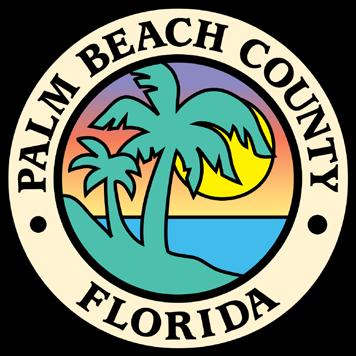
A REPORT FROM THE FLORIDA HOUSING COALITION FLHOUSING.ORG | THE FLORIDA HOUSING COALITION 25
28 HOME MATTERS 2023 28 THE FLORIDA HOUSING COALITION | FLHOUSING.ORG
St. Petersburg NTM-1 District
In March of 2023, the City of St� Petersburg adopted a new zoning district to enable small-scale multi-family developments in urban, walkable neighborhoods near daily destinations Key parameters for this new zone among other zoning regulations include:
• Allows up to four units in a building�
• Applies to locations that transition from a mixed-use corridor, center or “Future Major Street” (identified in the Comprehensive Plan) to a single-family neighborhood�
• At least 75% of the property must be outside the Coastal High Hazard Area, and density in the CHHA cannot be increased via these regulations
Communities in Florida with recent major reforms to ADU Regulations
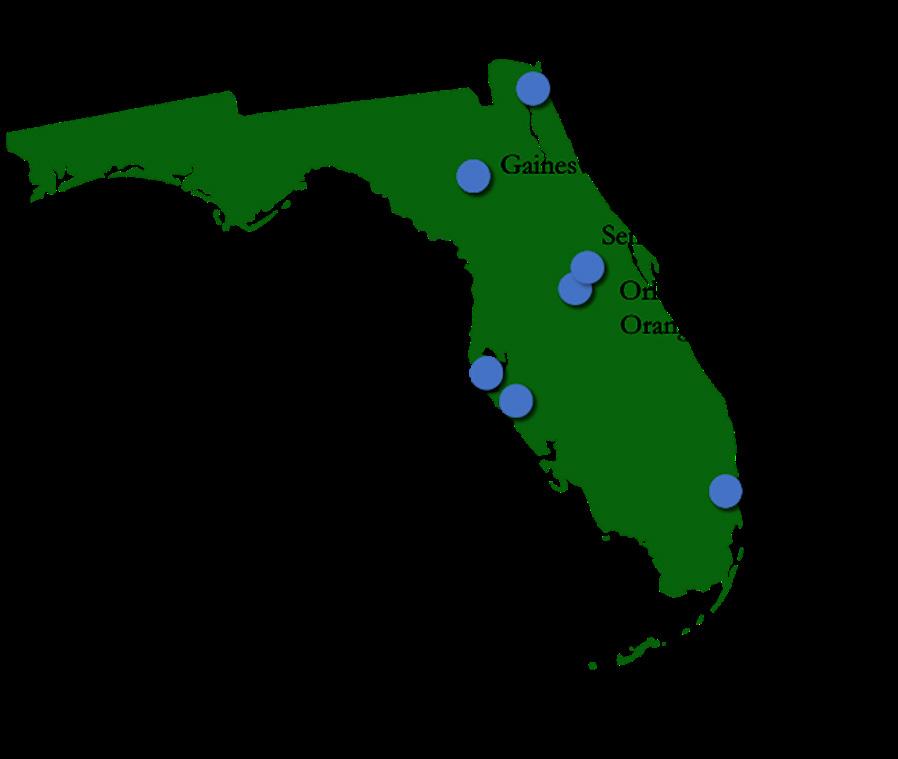
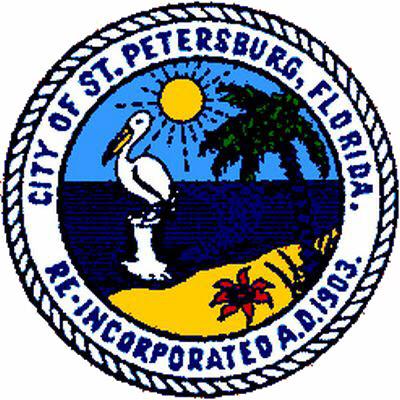
Inclusionary Housing
Inclusionary housing policies (sometimes called “inclusionary zoning”) refer to local land use regulations that either encourage or require the production of below-market, deed restricted units within a market-rate development Through voluntary inclusionary housing policies, communities use regulatory, financial, and procedural incentives to encourage affordable housing contributions from the private sector With mandatory
incentives to offset the costs of these requirements to developers House Bill 7103, that became law in 2019, requires local governments to “fully offset all costs” to the developer of their affordable housing contribution under a mandatory inclusionary zoning program Figure 4 shows communities with mandatory programs
HOME MATTERS 2023 THE FLORIDA HOUSING COALITION | FLHOUSING.ORG 26
29 A REPORT FROM THE FLORIDA HOUSING COALITION THE FLORIDA HOUSING COALITION | FLHOUSING.ORG 29
Figure 4
Communities with mandatory inclusionary zoning programs
Impacts of the Live Local Act
Local land use and zoning regulations are one of the first hurdles towards building more affordable homes in Florida� The Live Local Act signed into law in 2023 introduced new statewide land use standards to facilitate the development of affordable housing in commercial, industrial, and mixeduse districts Eligible developments are now entitled to favorable development standards in state law regarding use, density, height, and, in certain circumstances, administrative approval regardless of whether those standards conflict with the local government’s regulations The standards apply to multi-family or mixed-use residential rental developments proposed for an area zoned for commercial, industrial, or mixed-use, if at least 40% of the units are designated as affordable for households earning up to 120% AMI for a minimum of 30 years This Live Local "land use preemption,” as it has been referred to, can be utilized by affordable housing developers until 2033 See s� 125�01055(7)/166�04151(7) of Florida Statutes for more details, additional conditions, and exceptions that apply regarding the land use standards

Additionally, the Live Local Act provided three new property tax exemptions for affordable housing:
• Local option affordable housing property tax exemption: local governments can provide property tax exemptions for developments of 50 or more units with at least 20% of units affordable to households at or below 60% AMI
• Nonprofit land used for affordable housing with a 99-year ground lease: this exemption applies to land owned entirely by a nonprofit that is leased for a minimum of 99 years and predominantly used to provide affordable housing for households up to 120% AMI�
• “Missing middle” property tax exemption: this exemption applies to newly constructed multi-family developments that have more than 70 affordable units for households up to 120% AMI, excluding units subject to an agreement with FHFC to provide housing to persons up to 80% AMI and property receiving the previously mentioned local option property tax exemption
FLHOUSING.ORG | THE FLORIDA HOUSING COALITION 27
30 HOME MATTERS 2023 30 THE FLORIDA HOUSING COALITION | FLHOUSING.ORG
Figure 5
1339 (2020) Land Use Allowance
Note: Collier County is considering by-right allowances for affordable housing in commercial zones, similar to intent of HB 1339, and is included in the map.
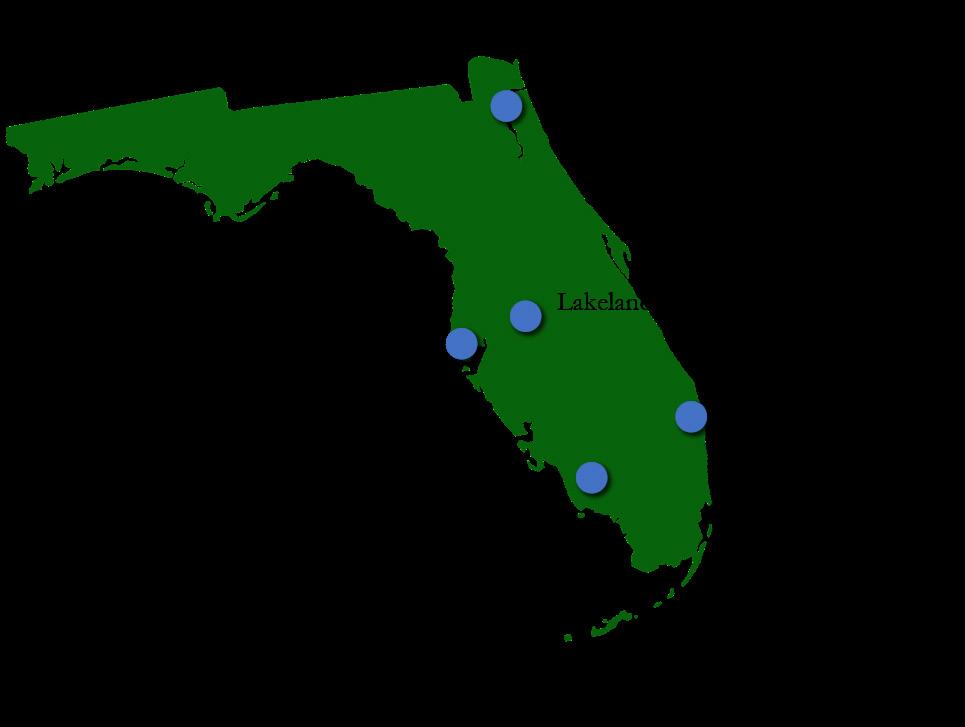
Community-Based, Nonprofit & BIPOC Developer Capacity
The Live Local Act also amended an existing land use tool for affordable housing commonly referred to as the “House Bill 1339” tool� House Bill 1339 in 2020 allowed local governments to approve developments with at least a 10% share of affordable units on any parcel zoned for residential, commercial, or industrial use without needing a rezoning or comprehensive plan amendment Local governments that have used this tool or actively considered adoption are shown in Figure 6� The Live Local Act amended the House Bill 1339 land use tool to remove its applicability to “residential” parcels, yet local governments can continue to use this discretionary tool for developments on parcels zoned for commercial and industrial uses that set-aside at least 10% of their units as affordable housing� Note that this is less than the required 40% of affordability that applies to projects that utilize Live Local Act’s land use preemption for eligible projects described previously in this section
In addition to the resources and regulations used to build affordable housing, solutions include diversifying the development community involved in providing the housing This effort can support community developers who might take on smaller scale housing projects, an approach promoted by organizations such as the Incremental Development Alliance Efforts can also include support for nonprofit developers that provide affordable housing, particularly developers identifying as Black, Indigenous, and People of Color (BIPOC) who are underrepresented in the developer field and who may come from communities experiencing legacies of disinvestment and discrimination Some funding avenues for affordable housing may include additional technical assistance to support nonprofit and community-based developers, such as the technical assistance associated with FHFC’s Predevelopment Loan Program
THE FLORIDA HOUSING COALITION | FLHOUSING.ORG 28
Governments that have used or are actively considering using HB
31 A REPORT FROM THE FLORIDA HOUSING COALITION THE FLORIDA HOUSING COALITION | FLHOUSING.ORG 31
Figure 6
Hannibal Square Community Land Trust, Inc. – Apopka

Townhomes
Hannibal Square Community Land Trust, Inc� is breaking ground at 350 East 6th Street in Apopka for one of two townhome projects for homeownership supported by the Predevelopment Loan Program administered by FHFC� Of the 24 total units, 12 will serve families with incomes between 80% to 120% AMI, and 12 will serve families with incomes between 50% and 80% AMI�
Conclusion
AFFORDABLE HOUSING IS ESSENTIAL FOR FLORIDIANS:

Having a healthy, affordable place to call home is the foundation of our lives and the basis of strong local economies Affordable housing allows low- and moderate-income working families to live near their places of employment and enables older adults and disabled family members on fixed incomes to be integrated with their communities
• Affordable housing construction and rehabilitation stimulate local economies by creating jobs and generating business for contractors and suppliers
• Affordable housing is essential for both public sector and private sector businesses to recruit and retain a workforce�
• Stable, quality affordable housing improves a family’s physical and mental health and helps children excel in school
• For older adults and people with disabilities, being able to live in affordable community care saves them,
their families, and taxpayers over 60% compared with institutional care
• For people who are chronically homeless, affordable housing breaks the costly cycle of return visits to hospitals, jails, and other taxpayer-funded crisis systems �
WE DON’T HAVE ENOUGH AFFORDABLE HOUSING IN
FLORIDA:
• An estimated 2 4 million low-income Florida households pay more than 30% of their incomes for housing, the maximum amount considered affordable by experts�
• Over 1�3 million very low-income households in Florida are severely cost burdened, meaning they pay more than 50% of their incomes for housing
• Though Florida has seen a significant decrease in homelessness over the past ten years, there are still over 25,000 individuals experiencing homelessness on any given night throughout the state In the 20212022 school year, 78,277 K-12 students experienced
A REPORT FROM THE FLORIDA HOUSING COALITION FLHOUSING.ORG | THE FLORIDA HOUSING COALITION 29
32 HOME MATTERS 2023 32 THE FLORIDA HOUSING COALITION | FLHOUSING.ORG
homelessness or housing instability Studies show that children experiencing homelessness have poorer health, mental health, and educational outcomes than their peers�
• “Drive till you qualify” is not a solution to high housing costs since transportation costs largely consume the housing cost savings In rural areas across Florida, households pay a larger share of household income towards housing and transportation than more urban residents, even with dramatically lower housing costs
THERE IS A LARGE AND GROWING GAP BETWEEN INCOME AND HOUSING COSTS:
• For a two-parent family of four to meet its basic needs in 2021, the parents needed to earn a combined wage of $33�16 per hour, which is about $16�58 per parent� Unfortunately, many of Florida’s jobs are still in occupations with median wages below $16 58 per hour, even as the cost of living has skyrocketed over the last two years
• Rents are out of reach for low-income workers in many Florida communities� For example, a restaurant cook cannot afford a moderately priced one-bedroom apartment in the Orlando, West Palm Beach, or Tallahassee areas
• Florida has only 23 affordable and available rental units for every 100 extremely low-income renters (those with incomes at or below 30% of the area median)�
• The median renter income in Florida is too low to afford median rents, and the gap between rents and renter incomes is wider now than it was at the height of the housing boom
• Median-priced homes in Florida are out of reach for many workers with medium- and high-skilled jobs�
• Over 83,687 units are at risk of being permanently lost from the privately owned affordable housing stock by 2043
• Florida has a shortage of moderately priced homes available for low-income homebuyers, partly due to competition from investors and second-home buyers In 2018, there were about nine low-income potential homebuyers for every home sold to an owner-occupant at or below the median sale price
THE GOOD NEWS
Although the affordable housing need in Florida is daunting, our state has a nationally acclaimed program based on a dedicated revenue source with a proven track record for performance, transparency, and accountability: The State and Local Housing Trust Funds created by the William E Sadowski Affordable Housing Act The largest State Housing Trust Fund program in Florida is the SAIL program, while the Local Government Housing Trust Fund supports SHIP programs in every county and all of Florida’s larger cities
The Sadowski programs are a powerful engine of economic development in Florida The State Legislature allocation to the Sadowski Trust Fund programs for housing in FY 20232024 will generate:
• Over $7�2 billion in positive economic benefit
• More than 56,000 jobs
• Over 18,000 housing units
In addition to boosting the state’s economy, SHIP and SAIL have helped hundreds of thousands of low- and moderateincome families move into affordable homes or renovate their current homes since 1992� SHIP and SAIL are Florida’s most important homegrown tools for providing housing for our most vulnerable populations, including:
• Older-adult households
• People with developmental disabilities
•Veterans and families experiencing homelessness
Affordable housing saves taxpayer dollars and improves the quality of life for these vulnerable populations�
With strong public-private partnerships leveraged by consistent state funding, we can help thousands of families move into decent, safe, affordable housing every year, boosting our state and local economies in the process Fully appropriating Sadowski Housing Trust Fund monies for housing is one of the best policy decisions we can make at this critical moment when Florida’s home prices and overall economy reach full recovery from the Great Recession
HOME MATTERS 2023 THE FLORIDA HOUSING COALITION | FLHOUSING.ORG 30
33 A REPORT FROM THE FLORIDA HOUSING COALITION THE FLORIDA HOUSING COALITION | FLHOUSING.ORG 33
SADOWSKI HOUSING COALITION MEMBERS


BUSINESS/ INDUSTRY GROUPS
• Associated Industries of Florida
• Coalition of Affordable Housing Providers
• Federation of Manufactured Home Owners of Florida
• Florida Apartment Association
• Florida Bankers Association
• Florida Chamber of Commerce
• Florida Green Building Coalition
BUSINESS/ INDUSTRY GROUPS
• Florida Home Builders Association
• Florida Manufactured Housing Association
• Florida Realtors
• Florida Restaurant and Lodging Association
• Florida Retail Federation
• Mortgage Bankers Association of Florida
ADVOCATES FOR THE ELDERLY/ VETS/ HOMELESS/ SPECIAL NEEDS
• AARP of Florida
• Florida Association of Centers for Independent Living
• Florida Association of Housing and Redevelopment Officials
• Florida Coalition to End Homelessness
• Florida Housing Coalition
• Florida Legal Services
ADVOCATES FOR THE ELDERLY/ VETS/ HOMELESS/ SPECIAL NEEDS
• Florida Prosperity Partnership
• Florida Supportive Housing Coalition
• Florida Veterans Foundation
• Florida Weatherization Network
• Healthy Housing Foundation
• LeadingAge Florida
• The Arc of Florida
• United Way of Florida
GOVERNMENT/ PLANNING ORGANIZATIONS
• American Planning Assoc., Fla. Ch.
• Florida Association of Counties
• Florida Association of Local Housing Finance Authorities
• Florida Housing Finance Corporation
• Florida League of Cities
• Florida Redevelopment Association
• Florida Regional Councils Association
• 1000 Friends of Florida
FAITH BASED ORGANIZATIONS
• Florida Conference of Catholic Bishops
• Florida Impact
• Habitat for Humanity of Florida
• Volunteers of America of Florida
Comprised of thousands of individuals, local, or regional organizations, Sadowski Affiliates are comprised of the local organizational members of the Sadowski Coalition members, such as local Realtors, United Way offices, and Habitat Affiliates, as well as hundreds of individuals throughout Florida who are not affiliated with any organization. They are Many Voices having One Message: Use all of the State and Local Housing Trust Funds for Housing. Keep the promise!
A REPORT FROM THE FLORIDA HOUSING COALITION FLHOUSING.ORG | THE FLORIDA HOUSING COALITION 31 34
05.2022 HOME MATTERS 2023 34 THE FLORIDA HOUSING COALITION | FLHOUSING.ORG
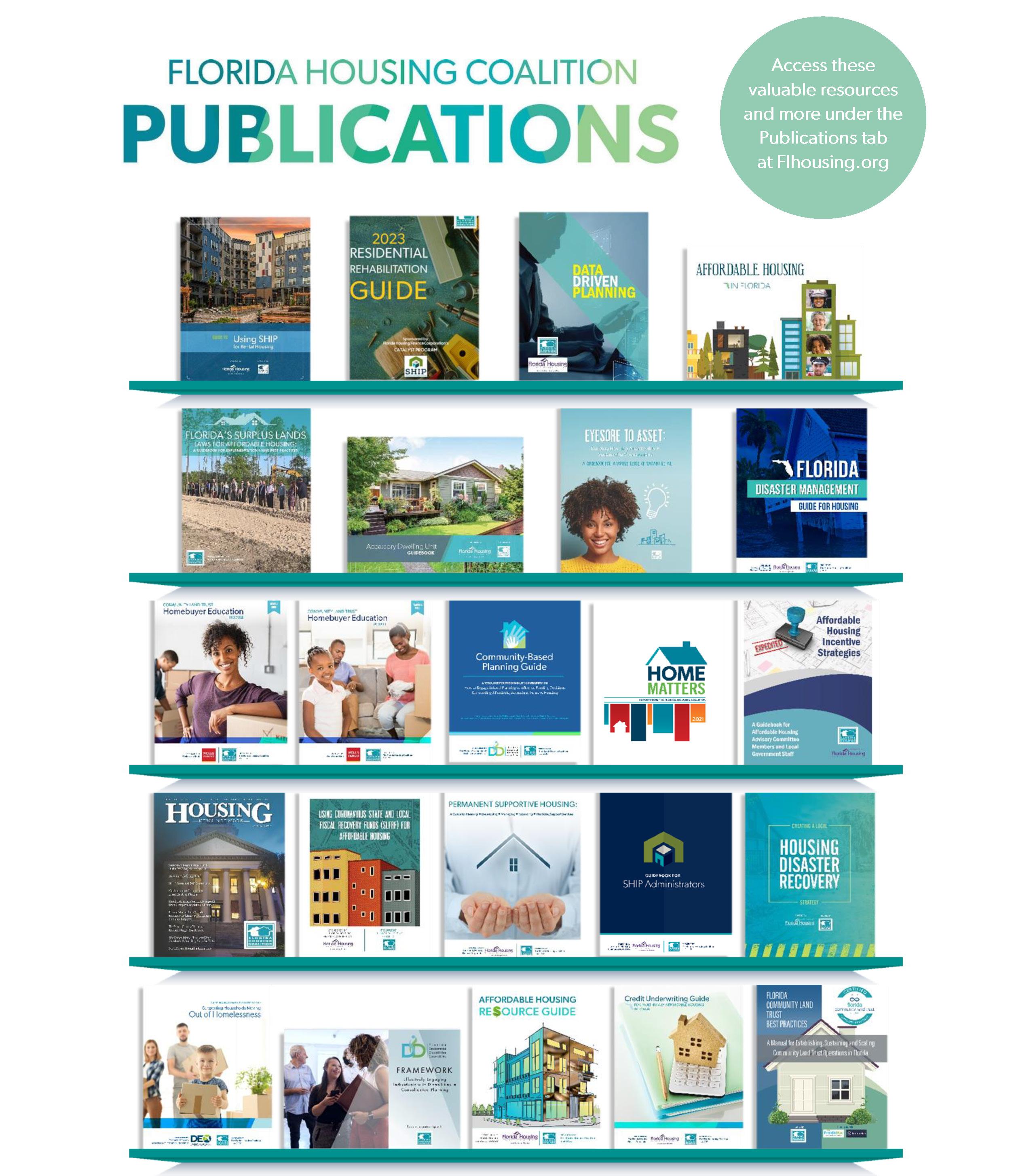
HOME MATTERS 2023 THE FLORIDA HOUSING COALITION | FLHOUSING.ORG 32 A REPORT FROM THE FLORIDA HOUSING COALITION THE FLORIDA HOUSING COALITION | FLHOUSING.ORG 35
Endnotes
1 Sadowski Affiliates 2023 https://flhousing org/wp-content/uploads/2023/04/Sadowski-Affiliates-Webinar-2023-04-07 pdf
2 Wardrip, K �, Williams, L �, and Hague, S� 2011� The Role of Affordable Housing in Creating Jobs and Stimulating Local Economic Development: A Review of the Literature� Washington, DC: Center for Housing Policy� Via The National Resource Network�
3 Golden, T 2016 Insufficient Affordable Housing Limits Florida’s Economic Potential Lake Mary, FL: Florida Policy Institute http://www fpi institute/insufficient-affordable-housing-limits-floridas-economic-potential/
4 Wardrip et al� 2011�
5 Golden 2016
6 Houser, A �, Fox-Grage, W�, and Ujvari, K � 2018� Across the States: Profiles of Long-Term Services and Supports� Washington, D�C �: AARP� https://www�aarp�org/content/dam/aarp/ppi/2018/08/florida-LTSS-profile�pdf�
7 Shinn, G A 2014 The Cost of Long-Term Homelessness in Central Florida Orlando, FL: Central Florida Commission on Homelessness http:// shnny org/uploads/Florida-Homelessness-Report-2014 pdf
8 Maqbool, N�, Vivieros, J�, and Ault, M � 2015� The Impacts of Affordable Housing on Health: A Research Summary� Washington, DC: Center for Housing Policy� http://media�wix�com/ugd/19cfbe_d31c27e13a99486e984e2b6fa3002067�pdf�
9 Center for American Progress 2020 The Pandemic Has Exacerbated Housing Instability for Renters of Color https://www americanprogress org/issues/poverty/reports/2020/10/30/492606/Pandemic-exacerbated-housing-instability-renters-color/
10 Ibid�
11 Newman, S J 2008 Does Housing Matter for Poor Families? A Critical Summary of Research and Issues Still to be Resolved Journal of Policy Analysis and Management, 27 (4): 895-925
12 Maqbool et al� 2015�
13 Newman 2008
14 National Health Care for the Homeless Council� 2011� Homelessness & Health: What’s the Connection? http://www�nhchc�org/wp-content/ uploads/2011/09/Hln_health_factsheet_Jan10�pdf�
15 Brennan, M , Reed, P , and Sturtevant, L A 2014 The Impacts of Affordable Housing in Education: A Research Summary Washington, DC: Center for Housing Policy http://media wix com/ugd/19cfbe_c1919d4c2bdf40929852291a57e5246f pdf
16 Children’s HealthWatch and Medical-Legal Partnership Boston� 2016� Housing as a Health Care Investment: Affordable Housing Supports Children’s Health� https://childrenshealthwatch�org/housing-as-a-health-care-investment-affordable-housing-supports-childrens-health/
17 Newman 2008
18 Newman, S�J� and Harkness, J� 1999� The Long-Term Effects of Housing Assistance on Self-Sufficiency: Final Report� Washington, DC: U�S� Department of Housing and Urban Development [HUD]� http://www�huduser�org/portal//Publications/pdf/longterm�pdf�
19 United Way of Florida 2020 ALICE (Assed Limited, Income Constrained, Employed): Study of Financial Hardship https://www uwof org/sites/ uwof org/files/2020ALICEHightlightsReport_FL_FINAL-4 15 20 pdf
20 Florida’s Council on Homelessness� Annual Report� 2023�
21 Data on student homelessness was obtained from the following sources provided by the National Center for Homeless Education: http:// center serve org/nche/
22 Shimberg Center� 2021 PUMS data�
23 Shimberg Center for Housing Studies 2019 [Lost Properties Inventory data for Florida] http://flhousingdata shimberg ufl edu/assisted-housinginventory/results?nid=1
24 Joint Center of Housing Studies� 2015� State of the Nation’s Housing
25 Shimberg Center 2021 PUMS data
26 Zillow 2016 Buying beats renting in less than two years, but millennials still have reason to rent http://zillow mediaroom com/2016-02-04Buying-Beats-Renting-in-Less-Than-Two-Years-But-Millennials-Still-Have-Reason-to-Rent�
27 Huddleston, C 2016 The cost of renting vs owning a home in every state GOBankingRates https://www gobankingrates com/mortgagerates/cost-renting-vs-owning-home-state/
28 Borns, P� 2016� Should you rent or buy? Fort Myers News-Press [online article]� http://www�news-press�com/story/news/2016/07/25/should-yourent-buy/87378596/�
29 National Association of Home Builders [NAHB] 2023 [NAHB/Wells Fargo Housing Opportunity Index (HOI) data for 2013 Q1 ] http://www nahb org/en/research/housing-economics/housing-indexes/housing-opportunity-index aspx
30 Shimberg Center� 2021 PUMS data�
A REPORT FROM THE FLORIDA HOUSING COALITION FLHOUSING.ORG | THE FLORIDA HOUSING COALITION 33
36 HOME MATTERS 2023 36 THE FLORIDA HOUSING COALITION | FLHOUSING.ORG
31 Zillow Housing Data https://www zillow com/research/data/
32 Mitchell, B , Franco, J , and Richardson, J 2018 HOLC “redlining” maps: The persistent structure of segregation and economic inequality
33 Florida Housing Coalition, Tenure by Race [See Figure]�
34 Opportunity Starts at Home Public Opinion Polling on Housing Instability During the COVID-19 Pandemic 2020
35 Shimberg Center 2021 PUMS data
36 Urban Institute 2009 Promoting Neighborhood Diversity: Benefits, Barriers, and Strategies
37 FEMA’s National Risk Index https://hazards fema gov/nri/map
38 Housing Coastal Flood Hazard Exposure tool developed by the University of Florida’s Shimberg Center for Housing Studies https://www arcgis com/apps/webappviewer/index html?id=06b7daffb2344a21b56ff507e3fba789&extent=-10302451 5241%2C2704615 7276%2C8021570 6%2C3789410 033%2C102100
39 Enterprise Community Partners’ Portfolio Protect tool, https://www enterprisecommunity org/impact-areas/resilience/building-resilient-futures/ portfolio-protect�
40 RiskFactor by the Streetlight Foundation https://riskfactor com/
41 HazardAware, sponsored and funded by the National Academies of Sciences, Engineering and Medicine https://www hazardaware org/
42 Florida Housing Coalition’s Resilience and Disaster Recovery team page, with publicly available Disaster Housing Task Force meeting recordings posted https://flhousing org/disaster-recovery/
43 Freemark, Y and Scally, C P 2023 LIHTC Provides Much-Needed Affordable Housing, But Not Enough to Address Today’s Market Demands Urban Institute, Urban Wire
HOME MATTERS 2023 THE FLORIDA HOUSING COALITION | FLHOUSING.ORG 34
A REPORT FROM THE FLORIDA HOUSING COALITION THE FLORIDA HOUSING COALITION | FLHOUSING.ORG 37
Affordable Housing is an Integral Part of Community Revitalization and Economic Development
The Florida Housing Coalition, Inc�, is a nonprofit, statewide membership organization which brings together housing advocates and resources so that all Floridians have a quality affordable home and suitable living environment�
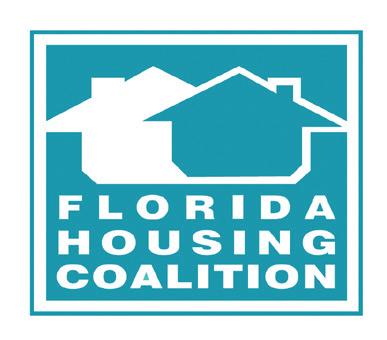
FOR MORE INFORMATION, CONTACT:
The Florida Housing Coalition 1311 N Paul Russell Road, B-201 Tallahassee FL 32301 (850) 878-4219
info@flhousing�org
FLHousing�org
The Florida Housing Coalition appreciates PNC for funding the Home Matters report





























































